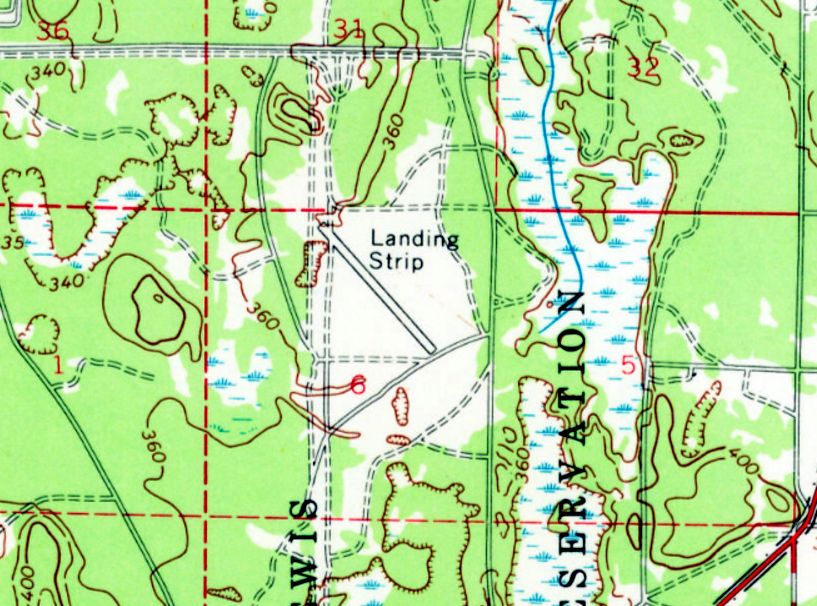
Abandoned & Little-Known Airfields:
Washington: Tacoma area
© 2002, © 2016 by Paul Freeman. Revised 11/17/16.
This site covers airfields in all 50 states: Click here for the site's main menu.
____________________________________________________
Please consider a financial contribution to support the continued growth & operation of this site.
Auburn Airfield (added 8/6/16) - Evergreen Airport / Evergreen Industrial Airport (revised 11/17/16) - Fort Lewis #1 Airfield (revised 11/17/16)
Gaffney's Lake Wilderness Resort Airfield (added 11/12/16) - Moss Field (revised 11/17/16)
Mueller-Harkins Field / Clover Park Technical College (revised 11/17/16) - South Tacoma Airpark (revised 8/7/16) - Tacoma Airport (revised 8/7/16)
____________________________________________________
Fort Lewis #1 Airfield, Spanaway, WA
47.079, -122.472 (South of Seattle, WA)

Ft Lewis #1 Airfield, as depicted on the 1961 USGS topo map.
This auxiliary airfield within Fort Lewis was evidently established at some point between 1958-61,
as it was not yet depicted on the 1958 USGS topo map.
The earliest depiction which has been located of Fort Lewis #1 Airfield was on the 1961 USGS topo map.
It depicted a single paved northwest/southeast runway, labeled simply as “Landing Strip”.
However the Fort Lewis #1 Airfield runway was not depicted on the 1965 Seattle Sectional Chart,
nor later Sectional Charts.
According to Lee Corbin, “From my years of flying the C-141 in & out of McChord AFB,
I always thought this strip was built for the C-130s that were based at McChord in the 1970s & 1980s,
but it shows up [on earlier] topo maps.”
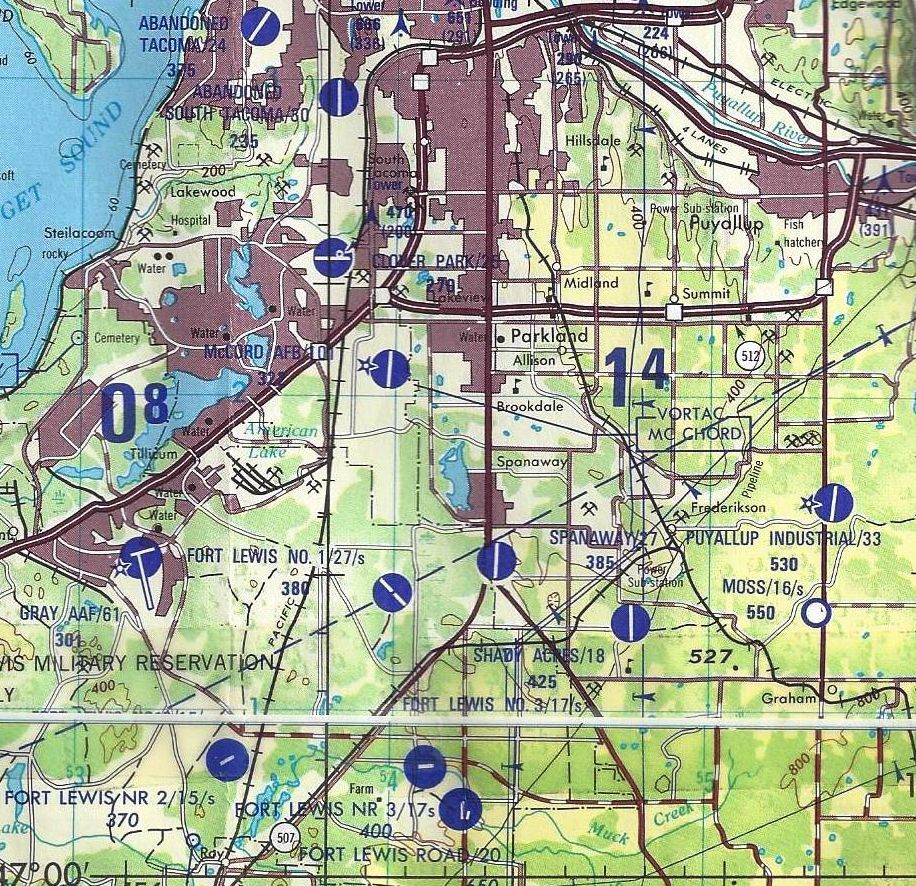
The only aeronautical chart depiction which has been located of Fort Lewis #1 Airfield was on a circa 1980s military aeronautical chart (courtesy of Lee Corbin).
It depicted Fort Lewis #1 as having a single northwest/southeast runway.
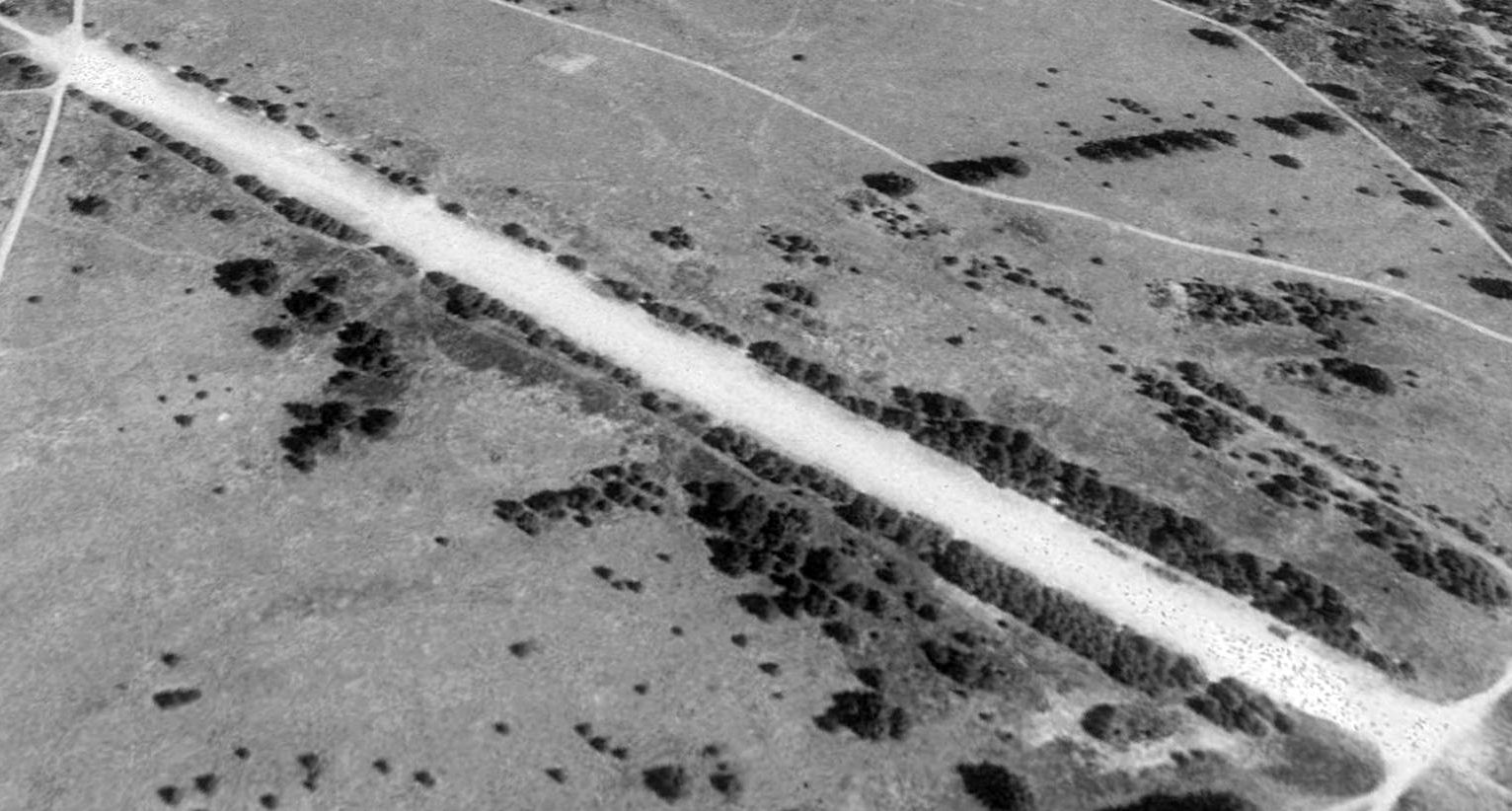
The earliest photo which has been located of Fort Lewis #1 Airfield was a 1990 USGS aerial view looking northeast.
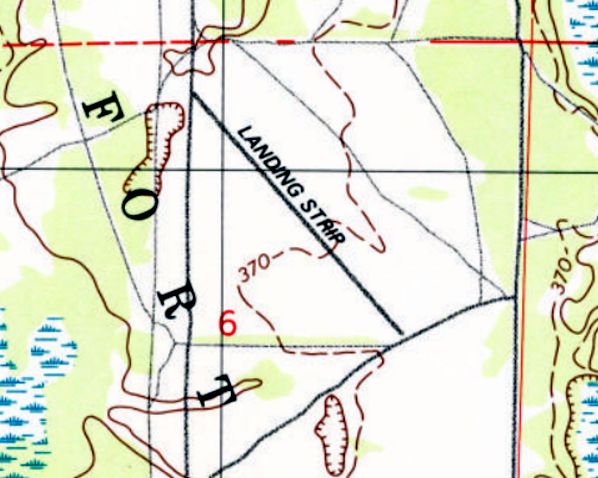
A 1997 USGS topo map depicted Fort Lewis #1 Airfield in the same fashion as the 1961 topo map.
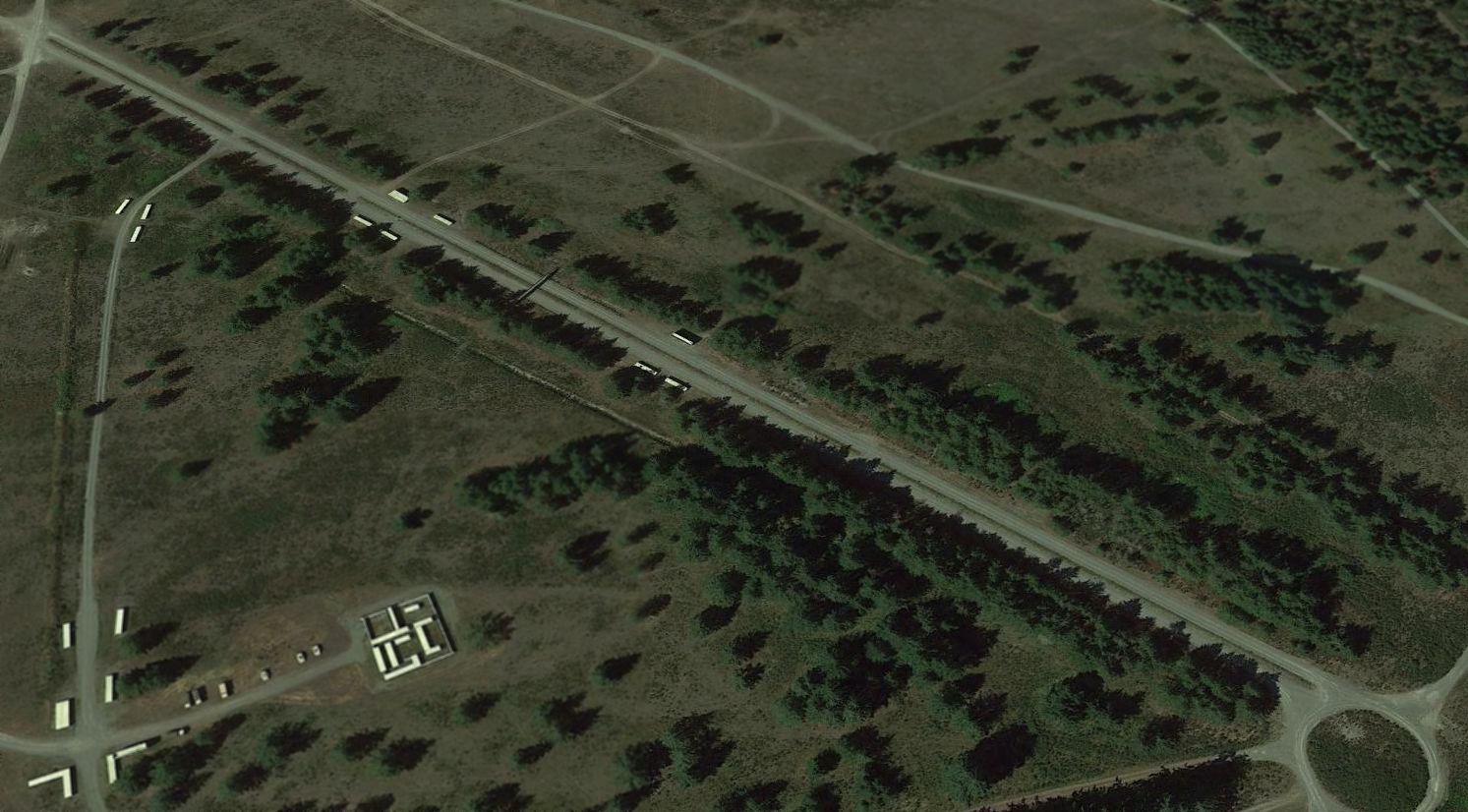
A 2016 aerial view looking northeast showed the Fort Lewis #1 Airfield runway appeared to have been reconfigured for non-aviation use,
with a median strip running down the length of its center, and a pedestrian footbridge across the middle.
The site of Fort Lewis #1 Airfield is located west of the intersection of Route 7 & Route 507.
Thanks to Lee Corbin for pointing out this airfield.
____________________________________________________
Gaffney's Lake Wilderness Resort Airfield, Maple Valley, WA
47.38, -122.039 (Southeast of Seattle, WA)
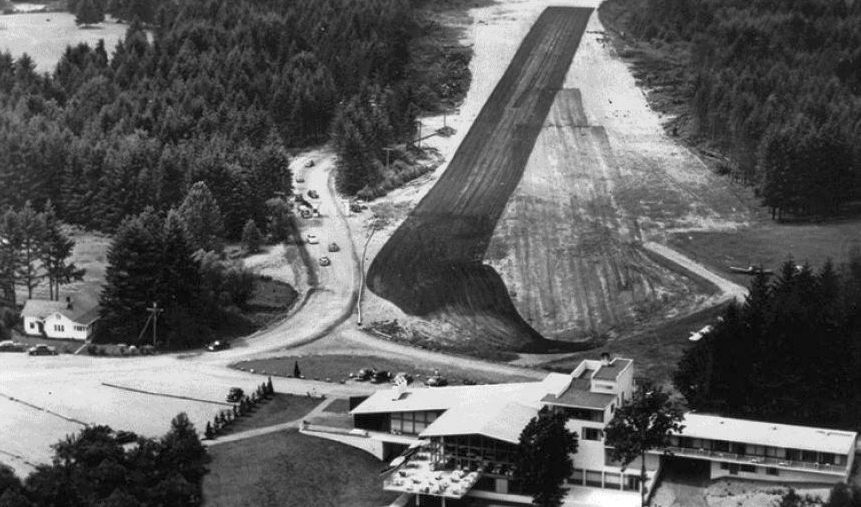
A 1950-59 aerial view looking west at Gaffney's Lake Wilderness Resort Airfield (courtesy of Lee Corbin), with one single-engine aircraft visible to the right of the runway.
According to a Maple Valley park brochure (courtesy of Lee Corbin), “Gaffney's Lake Wilderness Resort
was an active year-round vacation destination by the 1950s,
and included a boat & swim facilities, an airstrip, a ballroom, rental cabins, a restaurant, and a skating rink.
The airstrip was in operation from 1950.”
The earliest depiction which has been located of Gaffney's Lake Wilderness Resort Airfield was a circa 1950-59 aerial view.
It depicted a single east/west grass runway just beyond the Lake Wilderness Lodge.
One light single-engine aircraft was visible to the right of the runway.
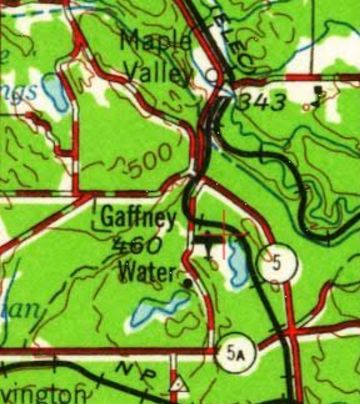
The only map depiction which has been located of Gaffney's Lake Wilderness Resort Airfield was on the 1962 USGS topo map (courtesy of Lee Corbin).
According to a Maple Valley park brochure (courtesy of Lee Corbin), “The airstrip was in operation to 1959.”
A 1964 aerial view showed Gaffney's Lake Wilderness Resort Airfield having been abandoned,
with the runway overgrown & only barely recognizable.
According to a Maple Valley park brochure (courtesy of Lee Corbin), “In 1967 King County Parks purchased Gaffney's property,
and many of the old cabins & facilities were torn down or relocated.”
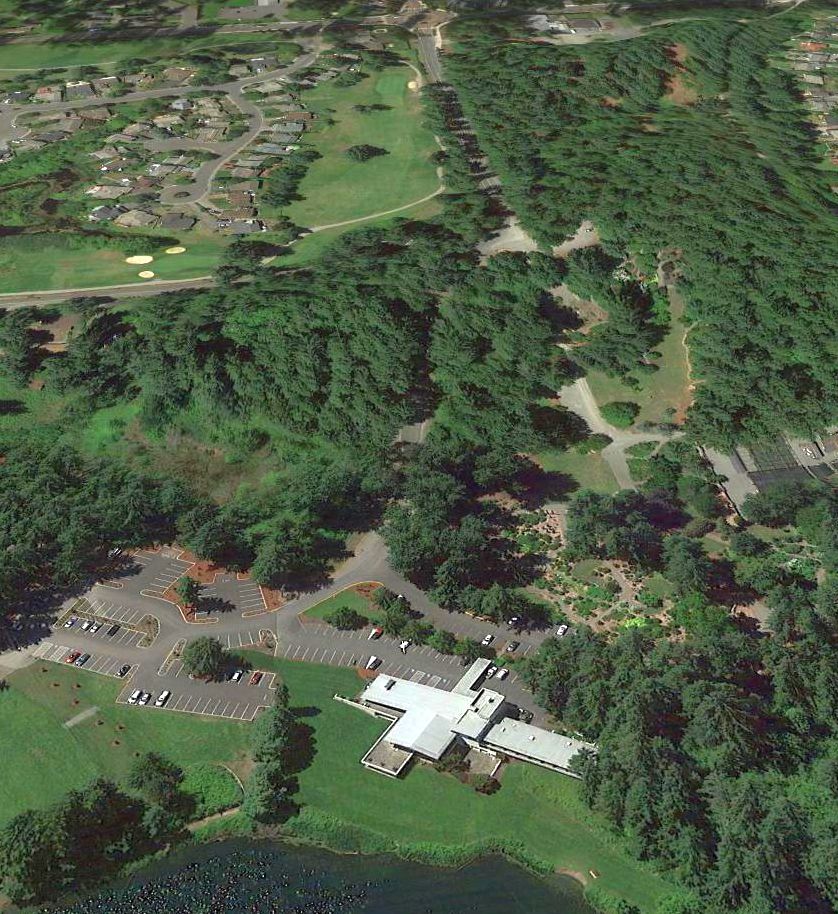
A 2016 aerial photo showed the Lake Wilderness Lodge remains, but no trace remains of Gaffney's Lake Wilderness Resort Airfield.
According to a Maple Valley park brochure (provided in 2016 by Lee Corbin), “The airstrip is now the site of Lake Wilderness Arboretum.”
The site of Gaffney's Lake Wilderness Resort Airfield is located at the eastern terminus of Gaffney Road.
Thanks to Lee Corbin for pointing out this airfield.
____________________________________________________
47.072, -122.298 (South of Seattle, WA)

Moss Field, as depicted on a circa 1980s military aeronautical chart (courtesy of Lee Corbin).
The date of establishment of this small private airfield has not been determined.
The earliest depiction which has been located of Moss Field was a 1969 aerial photo,
which depicted a single east/west grass runway.
The earliest aeronautical chart depiction which has been located of Moss Field was on a circa 1980s military aeronautical chart (courtesy of Lee Corbin).
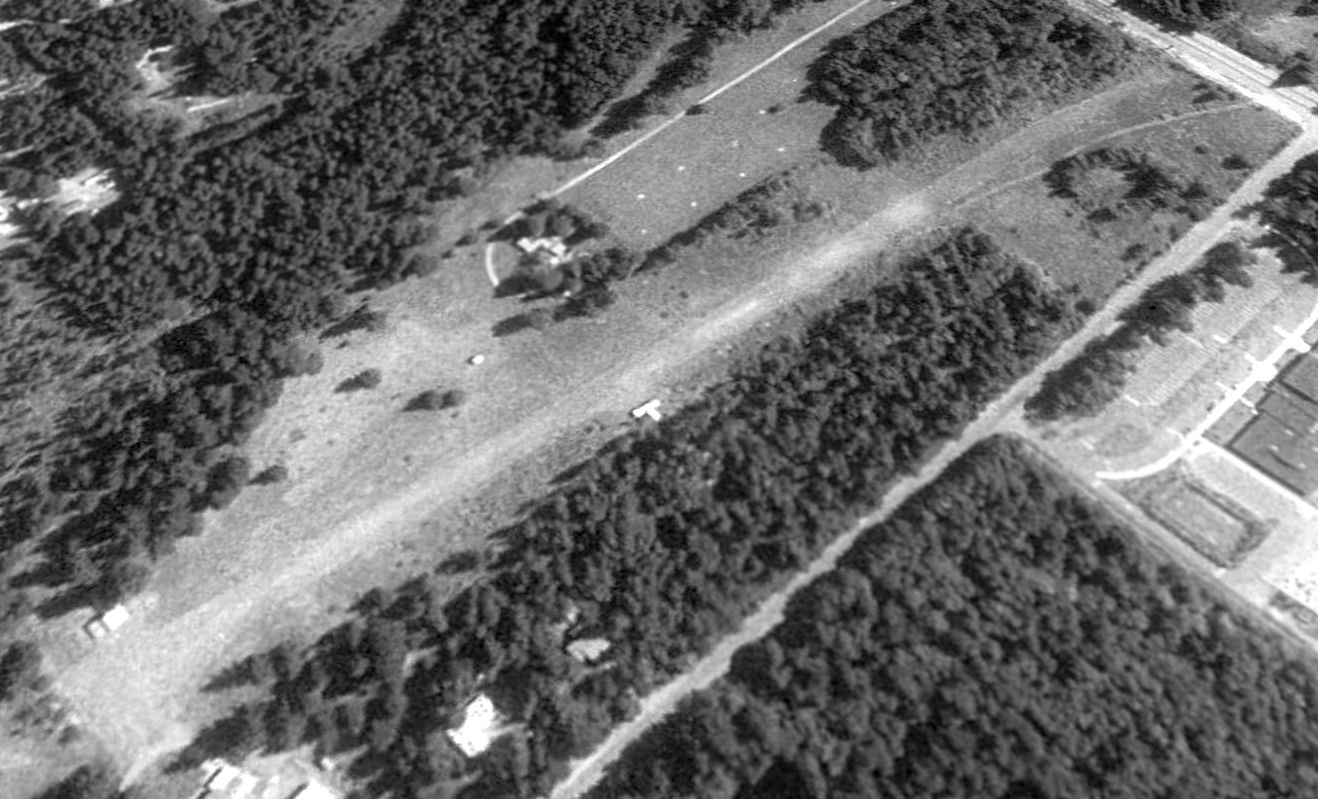
The earliest photo which is available of Moss Field was a 1990 USGS aerial view looking northeast.
It depicted Moss Field as having a single east/west grass runway,
with a small shed on the northwest side, and a T-hangar on the south side.
A house at the southwest side of the runway appeared to have had a taxiway leading toward the runway.
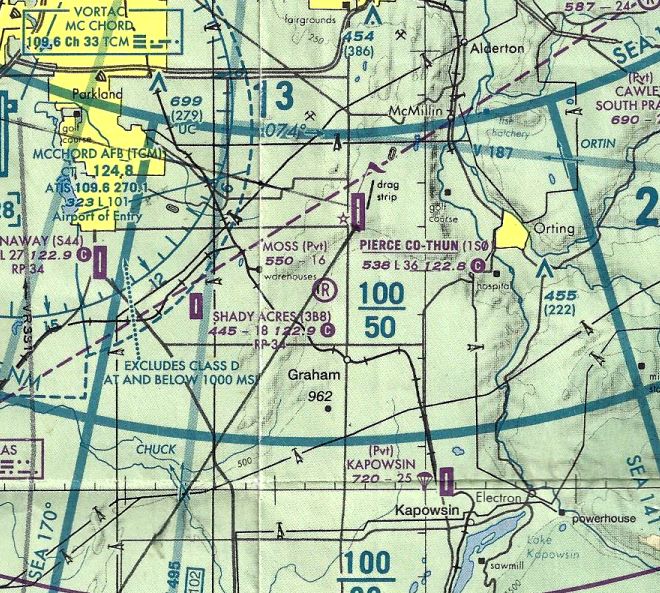
The last aeronautical chart depiction which has been located of Moss Field was on the 2000 Seattle Terminal Aeronautical Chart (courtesy of Lee Corbin).
It depicted Moss as a private airfield having a 1,600' unpaved runway.
Moss Field had a single 1,584' grass Runway 9/27.
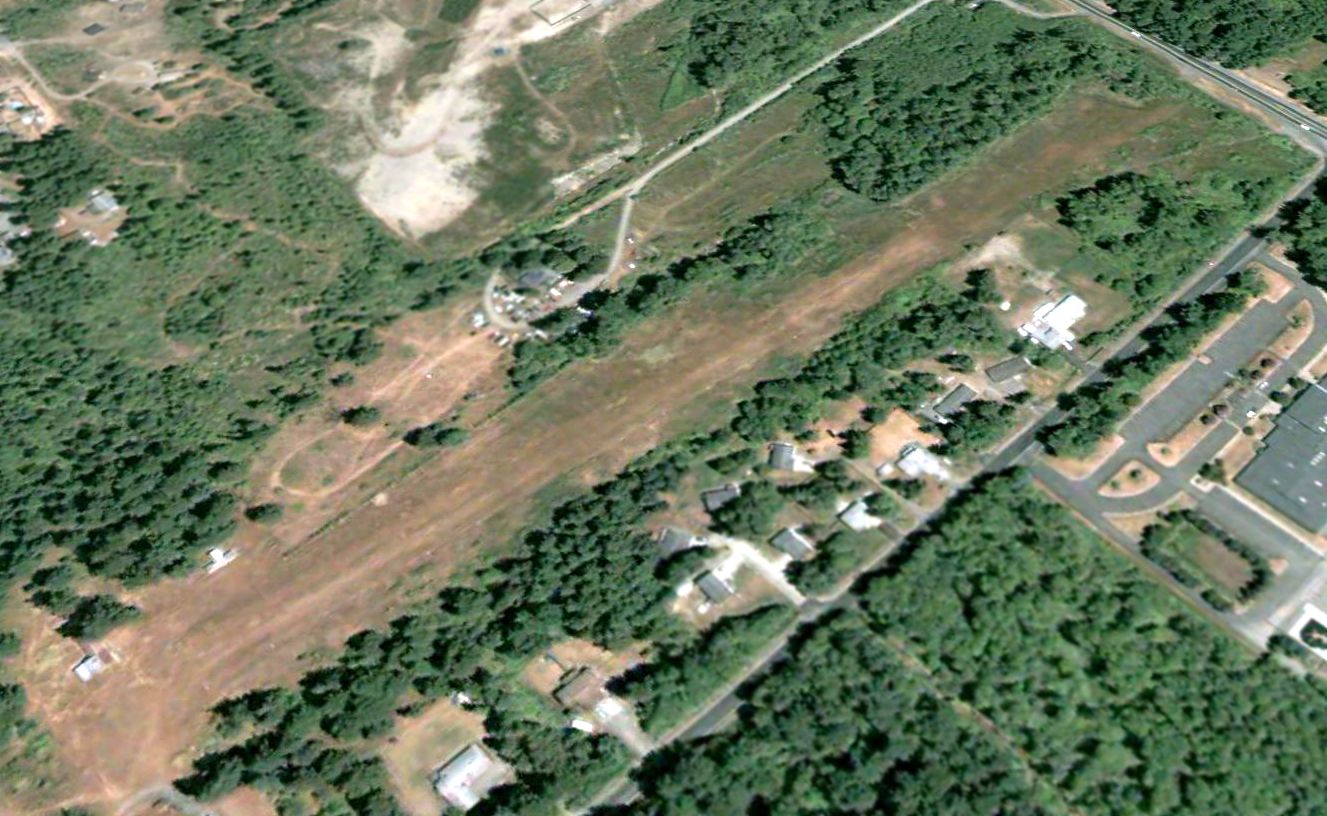
The last depiction which has been located of Moss Field was a 2003 aerial view looking northeast.
A small shed/hangar & a T-hangar were visible on the northwest side of the grass runway.
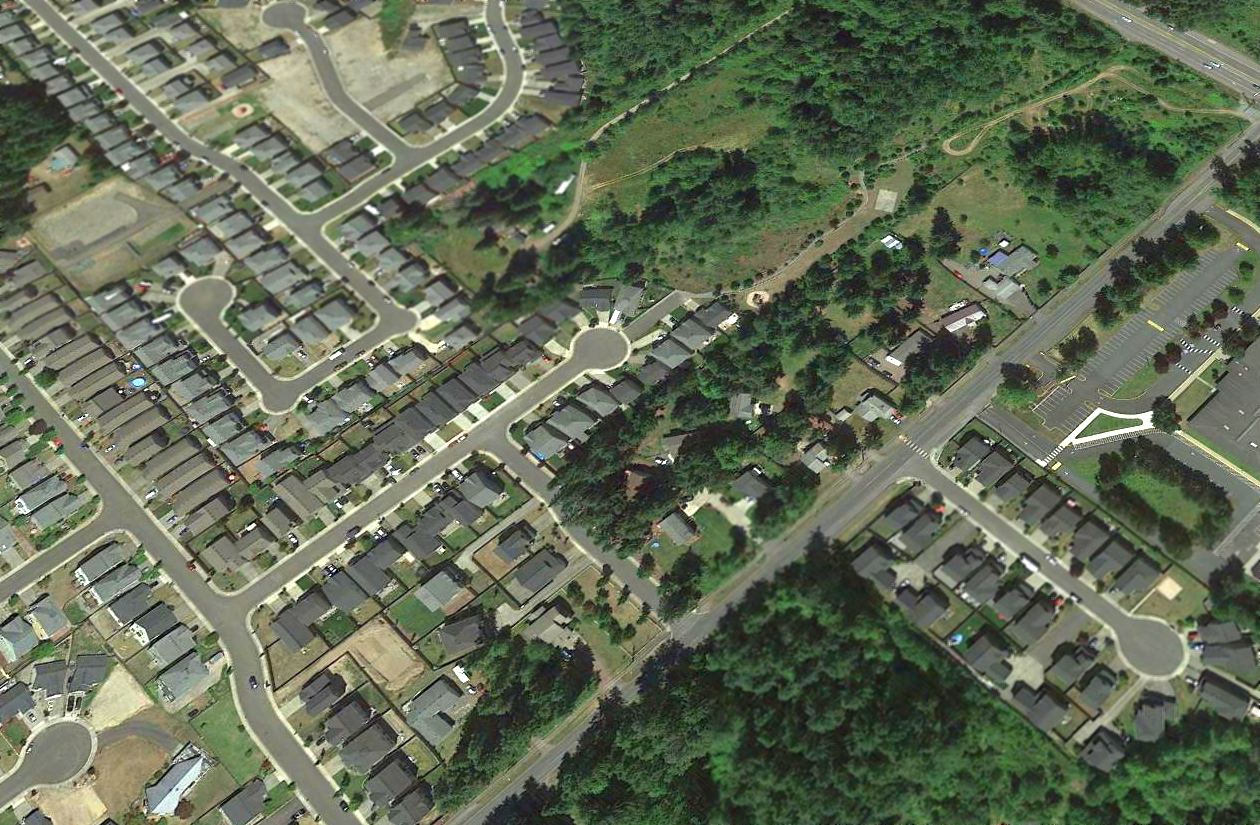
A 2016 aerial photo showed no trace remaining of Moss Field, with houses covering the western portion of the site.
Lee Corbin obserbved that the house at the bottom-left of this picture actually is left over from the site's airfield days, squeezed in among newer houses.
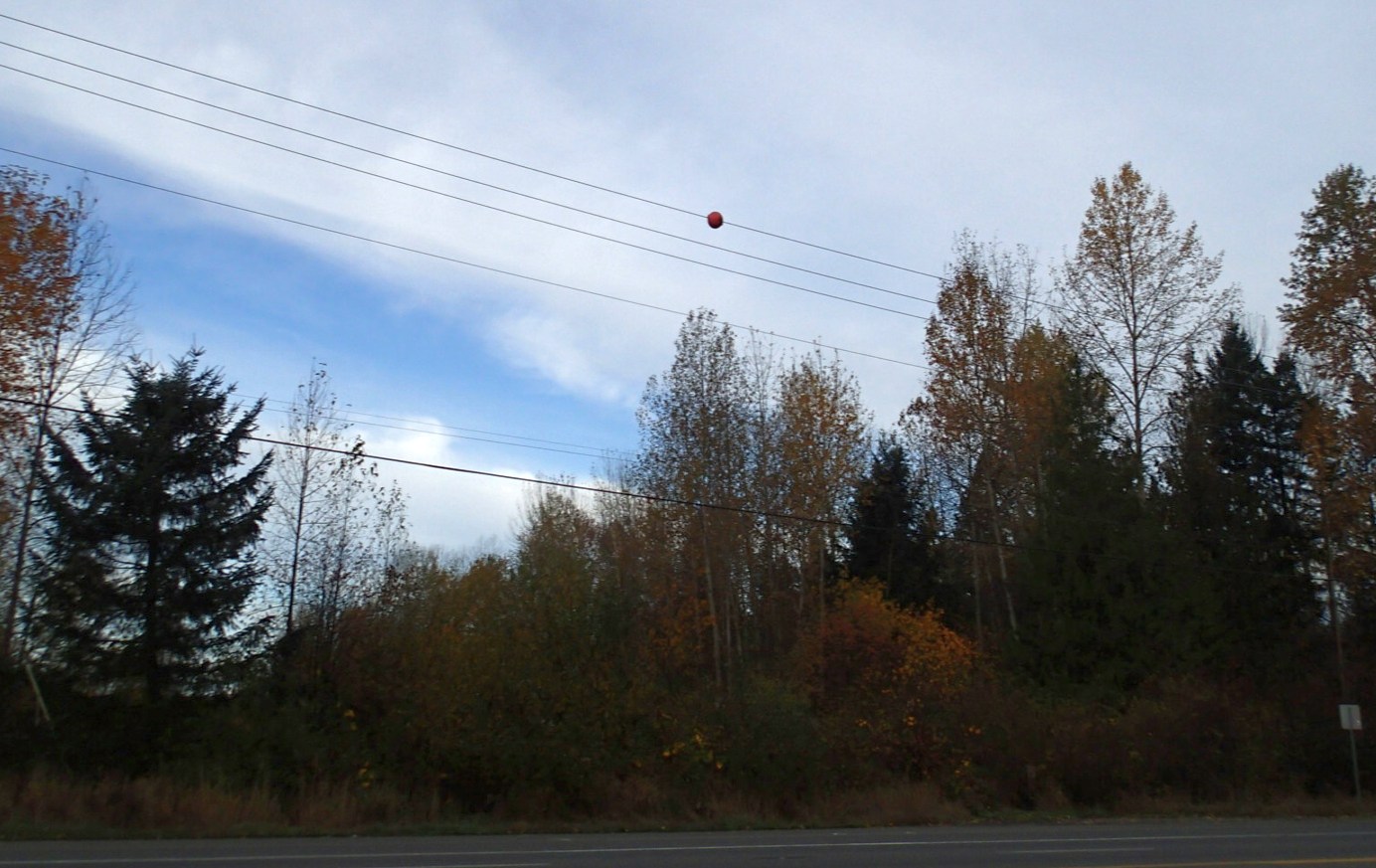
An 11/10/16 photo by Lee Corbin of the last tiny trace remaining of Moss Field: a single red marker ball mounted on an adjacent powerline.
Lee reported, “I've been driving by it for 26 years.”
The site of Moss Field is located northwest of the intersection of Meridian Avenue East & 204th Street East.
Thanks to Lee Corbin for pointing out this airfield.
____________________________________________________
47.293, -122.196 (South of Seattle, WA)
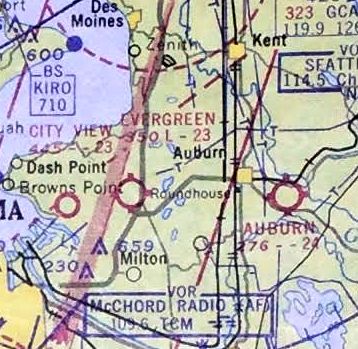
Auburn Airfield, as depicted on the October 1962 Seattle Sectional Chart (courtesy of Steve Martin).
Photo of the airfield while open is not available.
This small general aviation airport on the southeast side of Auburn (a different facility than the later Auburn Municipal Airport to the northwest)
was apparently established at some point between 1940-55,
as it was not yet depicted on a 1940 aerial photo.
The earliest depiction which has been located of Auburn Airfield was a 1955 aerial photo.
It depicted Auburn as having a northeast/southwest grass runway,
with 8 light single-engine aircraft parked near some small buildings on the south side.
A 1959 aerial photo showed Auburn Airfield had gained 2 hangars at some point between 1955-59.
The earliest depiction which is available of Auburn Airfield
was on the October 1962 Seattle Sectional Chart (courtesy of Steve Martin).
It depicted Auburn as having a 2,400' unpaved runway.
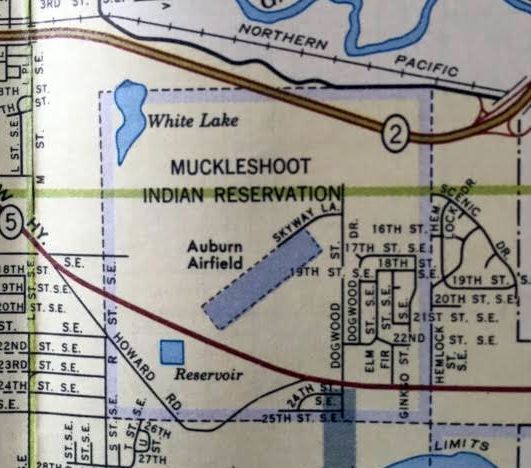
A 1962 street map (courtesy of Kevin Walsh) depicted Auburn Airfield as a northeast/southwest property outline within the Muckleshoot Indian Reservation.
A 1964 aerial photo showed over a dozen light single-engine aircraft parked on the south side of Auburn Airfield.
Auburn Airfield was evidently closed (for reasons unknown) at some point between 1964-65,
as it was no longer depicted at all on the June 1965 Seattle Sectional Chart (courtesy of Ron Kunse).

The 1968 USGS topo map depicted “Auburn Airfield” as an irregularly-shaped property outline
with 2 small buildings (hangars?) on the south side.
A 1968 aerial photo showed multiple closed-runway “X” symbols along the Auburn Airfield runway, and all the aircraft were gone.
A 1969 aerial photo showed Auburn Airfield remained in an unchanged condition.
A 1970 aerial photo showed construction had begun over the western portion of the Auburn Airfield site,
but a few of the smaller airfield buildings remained on the southeast corner.
Auburn Airfield's clearing was still depicted on the 1973 USGS topo map, but it was no longer labeled as an airfield.
A 1980 aerial photo showed houses covering the site of Auburn Airfield,
erasing the last traces of this little grass-roots airfield.

A 2016 aerial photo showed no trace remaining of Auburn Airfield,
with the Muckleshoot Casino occupying southern portion of the site.
The site of Auburn Airfield is located at the western terminus of Skyway Lane, appropriately enough.
Thanks to Kevin Walsh for pointing out this airfield.
____________________________________________________
Evergreen Airport / Evergreen Industrial Airport, Federal Way, WA
47.31, -122.32 (Southwest of Seattle, WA)
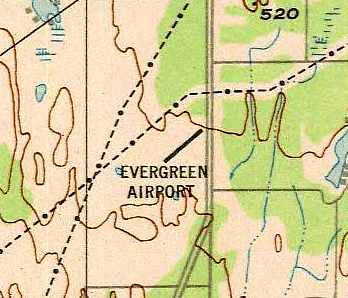
Evergreen Airport, as depicted on the 1948 USAF Target Complex Chart.
This general aviation airport was apparently established at some point between 1945-47,
as it was not depicted on a 1936 aerial photo nor on the 1945 Seattle Sectional Chart (courtesy of John Voss).
The earliest record of Evergreen Airport in its FAA Inspection File (according to David Field) was on 7/14/47.
The earliest depiction of Evergreen Airport which has been located
was on the 1948 USAF Target Complex Chart.
It depicted Evergreen Airport as having a single northeast/southwest runway.
The October 1948 Seattle Sectional Chart (courtesy of Chris Kennedy)
depicted Evergreen Airport as having a 2,200' runway.
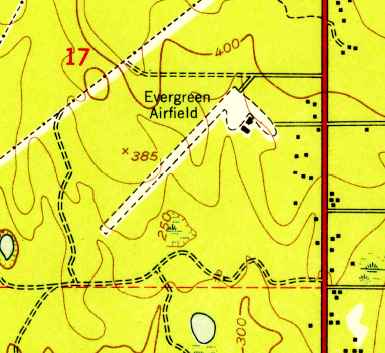
The 1949 USGS topo map depicted Evergreen Airfield as having a single unpaved northeast/southwest runway,
with a parking area & 2 small buildings on the east side.
Steve Martin recalled, “I have very fond & nostalgic memories of Evergreen Airport,
as my dad kept his Piper Apache there in the late 1950s & early 1960s & took me flying many times as a little tyke.
He had passed away by the time I was learning to fly, but I've always had a sentimental attachment to that crude little dirt strip.”
Evergreen Airport had a total of 19 based aircraft in 1961,
according to its FAA Inspection File (according to David Field).
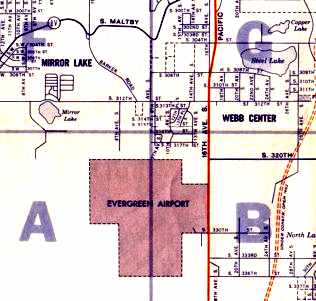
The 1961 Flying A road map (courtesy of Bill Eaton) depicted the outline of the Evergreen Airport property.
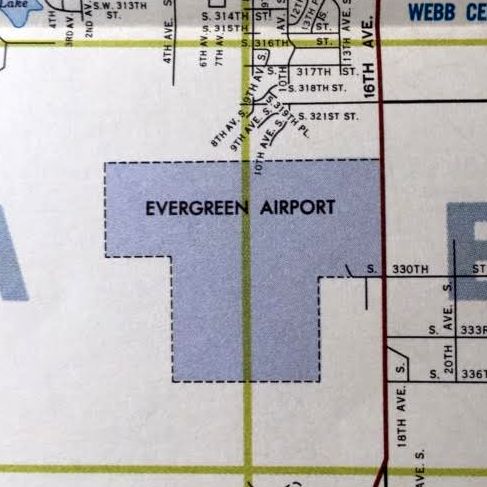
A 1962 street map (courtesy of Kevin Walsh) depicted a somewhat different property outline for Evergreen Airport.

The October 1962 Seattle Sectional Chart (courtesy of Steve Martin)
depicted Evergreen as having a 2,300' unpaved runway.
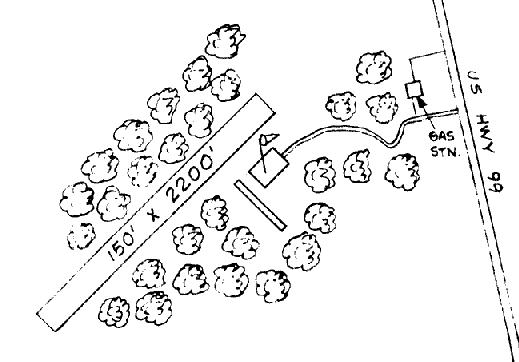
The 1963 WA Airport Directory (courtesy of Ron Dupas)
described Evergreen Airport as a private field,
with a single 2,200' gravel northeast/southwest runway.
A single hangar with a wind sock was depicted on the east side of the field.
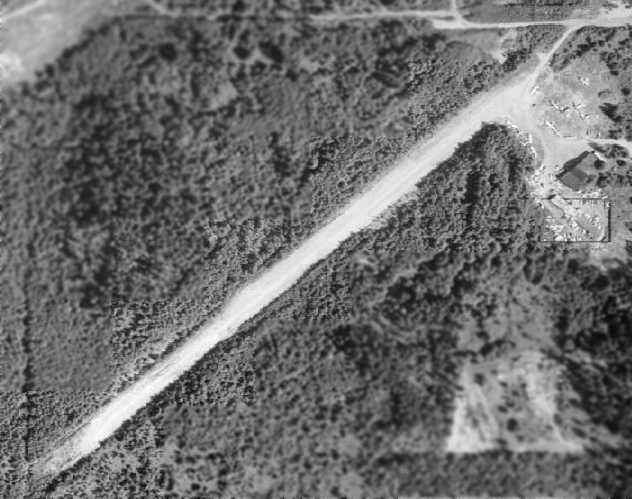
The earliest photo which has been located of the Evergreen Airport was a 1964 aerial view.
It depicted the field as having a single unpaved northeast/southwest runway.
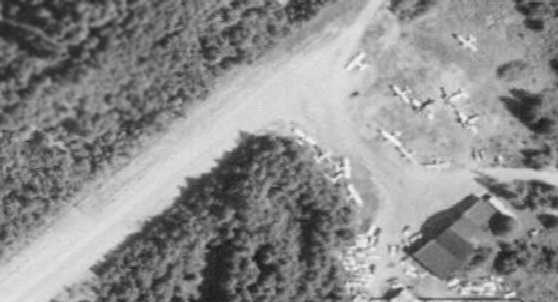
A closeup from the 1964 aerial view, showing 13 single-engine aircraft parked on the northeast end of the field.
Evergreen Airport may have gone through some period of abandonment starting at some point between 1964-65,
as it was was not depicted at all on the June 1965 Seattle Sectional Chart (courtesy of Ron Kunse),
the 1967 Seattle Sectional Chart (courtesy of John Voss),
or the December 1968 Seattle Sectional Chart (courtesy of Chris Kennedy).
Evergreen Airport appeared abandoned in a 1968 aerial photo.
In 1968 Evergreen Airport's owner requested reactivation as a public use airport,
according to its FAA Inspection File (according to David Field).
In 1969 the FAA issued “No objection provided it was operated as private use only”,
according to Evergreen Airport's FAA Inspection File (according to David Field).
In 1970, the FAA objected to public use due to Evergreen Airport being directly under the approaches for Sea-Tac airport,
according to its FAA Inspection File (according to David Field).
The FAA decided that if it were private use,
there would be less of a safety concern because the users could be advised of the Sea-Tac flight track issue.
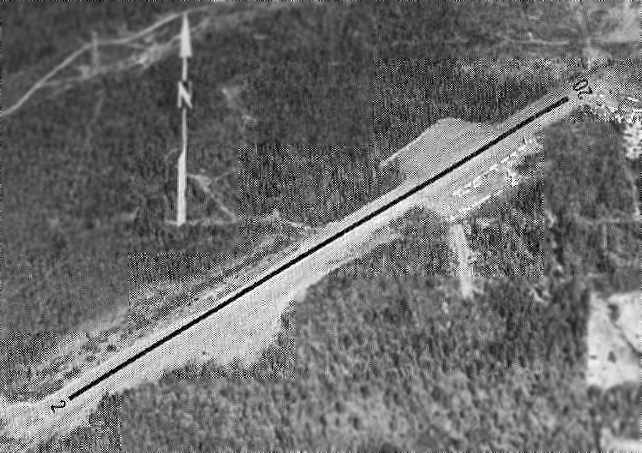
Evergreen Airport was listed once again as a public-use airport in the 1971 WA Airport directory (courtesy of Chris Kennedy).
This aerial view looking north at Evergreen Airport showed at least a dozen planes parked next to the runway.
The directory described the field as having a single 2,000' gravel-dirt Runway 2/20,
and listed the manager as Jack Haworth.
In 1973, after the Sea-Tac airspace was modified, FAA issued a “No objection” to public use
“provided power line towers be lighted & the pattern altitude be established at 800 feet”,
according to its FAA Inspection File (according to David Field).
In 1975, the Weyerhauser real estate division owned the property on which the southerly 600' or 700' of runway was located,
according to its FAA Inspection File (according to David Field).
The owners of the airport had not obtained a lease authorizing use of the property for airport purposes.
Weyerhauser filed for an injunction against the airport owners to prevent use of the Weyerhauser property.
This eventually led to the airport owners obtaining a lease.
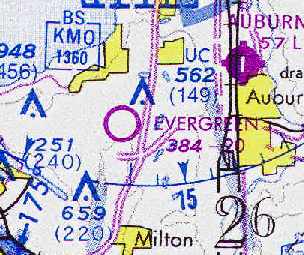
The January 1975 Seattle Sectional Chart (courtesy of Chris Kennedy)
depicted Evergreen as having a 2,000' unpaved runway.

A Winter 1976/77 aerial view by Steve Martin looking west at Evergreen Airport.
Steve recalled, “Evergreen Airport was pretty rough, adjacent to a junkyard
and the runway was just a slot cut through the tall fir trees with a very rough dirt & glacial rock runway that often dented propellers & tail feathers too.
The local pilots would every so often walk the strip & harvest the rocks that had migrated to the surface through the clay soil.”
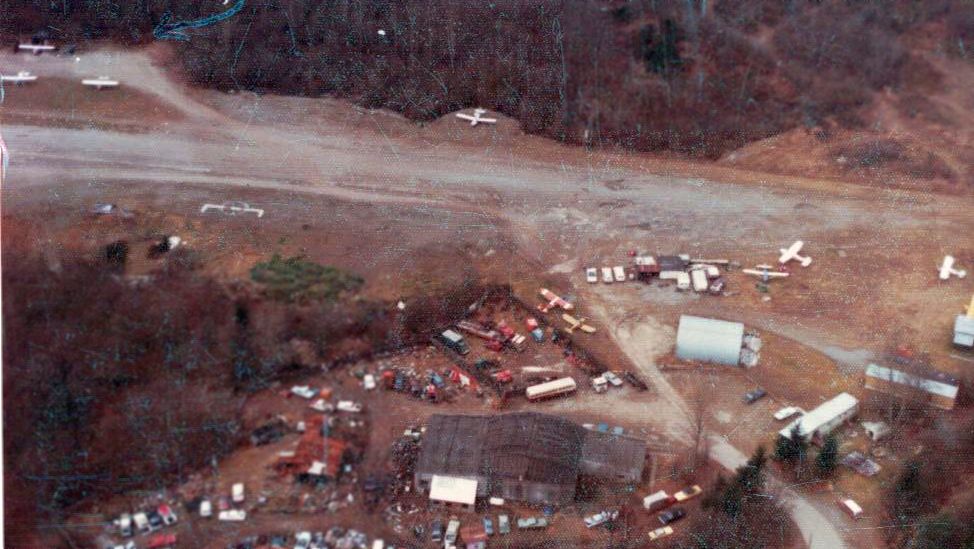
A Winter 1976/77 aerial view by Steve Martin looking west at Evergreen Airport's tiedown area & the adjacent junkyard.
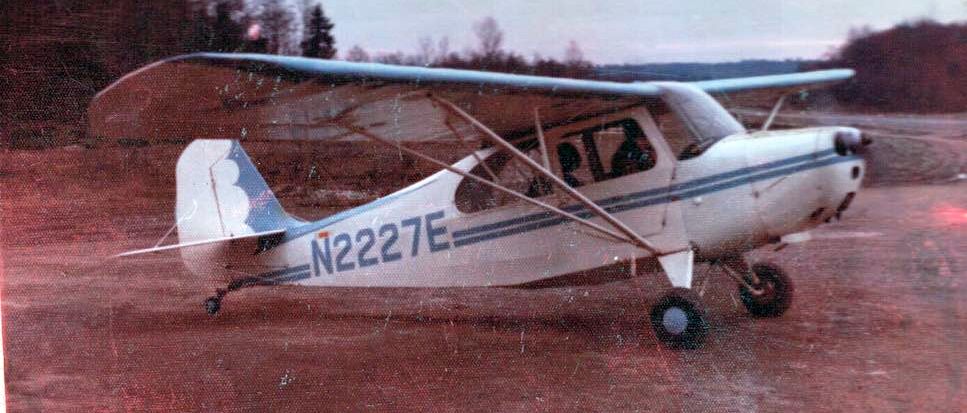
A Winter 1976/77 photo by Steve Martin of his 1946 Aeronca 7AC Champ at Evergreen Airport.
Steve Martin recalled, “I learned to fly at Evergreen Airport in 1976, taking lessons from a WWII P-51 veteran,
and I kept my 1946 Aeronca 7AC Champ there until the airport closed around 1979.
My high school friend Bryan Gilbert (we were both 16 years old) and I bought the Champ from Harry Hood for $2,350 in Hoquiam, WA
and flew it for several years before I bought him out & subsequently sold it a few years later to the well-known antique airplane restorer, my friend Glen Cawley.
I still fly that Champ, which has been expertly restored in factory original colors with a new and more powerful 85hp engine, some 38 years later.”
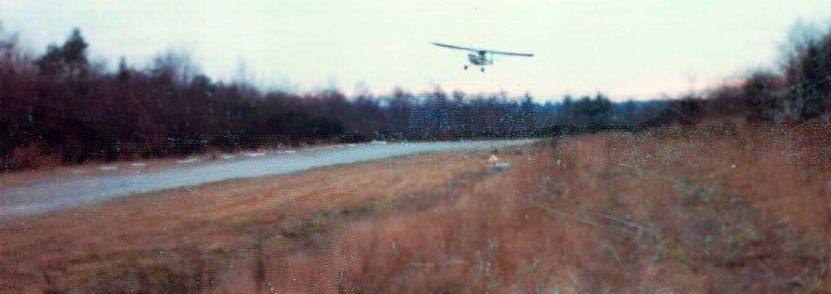
A Winter 1976/77 photo (courtesy of Steve Martin) of him slipping his 1946 Aeronca 7AC Champ on approach at Evergreen Airport.
Steve Martin recalled, “It was quite turbulent when the winds blew from the southwest & tumbled over the trees.
Landing to the south was challenging because of the high-tension power lines just a quarter mile or so to the north of the strip.
I remember Jack Haworth, the manager as a very likable, 'old school' pilot that had flown the Alaska bush a lot in his Cessna 180
and offered good piloting advice to youngsters like Bryan & myself.”
Steve Martin recalled, “Bryan & I made some really cool tie-down anchors for the Champ,
sinking eye bolts with big washers in concrete, then putting our initials and the date (sometime in 1976) in the wet concrete.
I miss that dumpy little field greatly, but I feel very fortunate to have experienced general aviation near its peak
and to have gained skills there that still serve me today as a Captain for Alaska Airlines.”
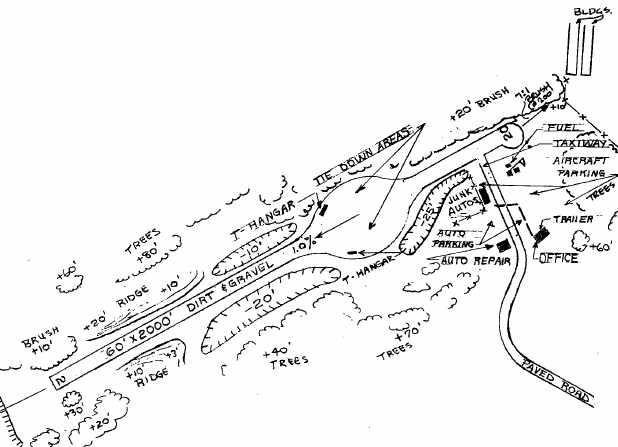
A 1978 FAA diagram of Evergreen Airport (courtesy of David Field)
depicted it as having a single 2,000' dirt & gravel Runway 2/20,
with an unusually shaped bulged tie-down area in the middle.
Two T-hangars were located in the tie-down area,
and the office was located on the southeast side of the field.
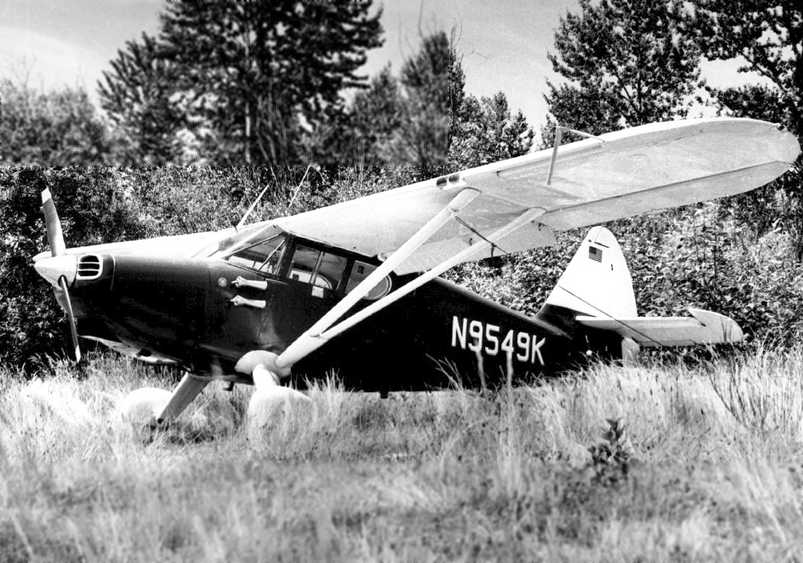
A 1978 photo of an unidentified taildragger at Evergreen by Owen Blauman.
Owen Blauman observed, “One of several late 1940s vintage planes that were housed at the airport in 1978. Pilots could fill up on the 'honor system'."
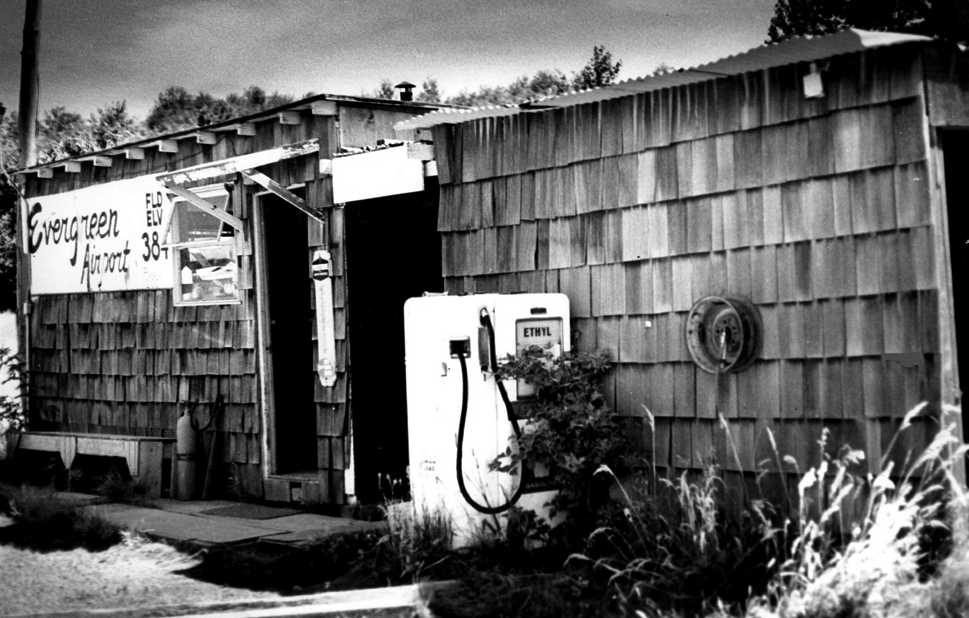
The last photo which has been located of Evergreen Airport was a 1978 photo by Owen Blauman.
Owen Blauman observed, “It looks more like a rural outpost, but this is the 'hub' of Evergreen Industrial Airpark.
The faded sign informs pilots that the field elevation is 384 feet above sea level."
In 1978, the owner of the airport, Environmental Research & Development Corporation,
shortened the northeast end by 450' to provide a 20 to 1 approach over the power lines & a building,
according to its FAA Inspection File (according to David Field).
In 1979, Environmental Research & Development Corporation terminated operation of the airport,
according to its FAA Inspection File (according to David Field).
According to David Field, “After closure of the airport, the Weyerhauser property was developed as an office complex
and the E.R.& D. property appears to have become a park.”
A 1980 aerial view showed the airport to be abandoned.
By the time of the 1980 USGS topo map, the single northeast/southwest runway was still depicted,
but it was labeled simply as "Landing Strip".
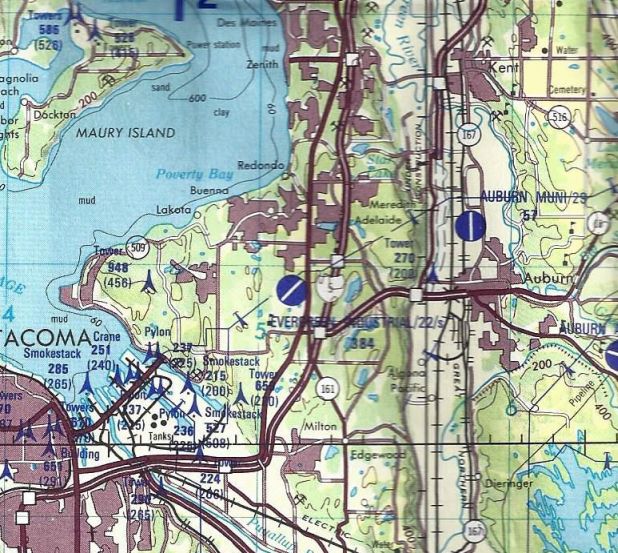
The last aeronautical chart depiction which has been located of Evergreen Airport was on a circa 1980s military aeronautical chart (courtesy of Lee Corbin).
It depicted “Evergreen Industrial” Airport as having a single northeast/southwest runway.
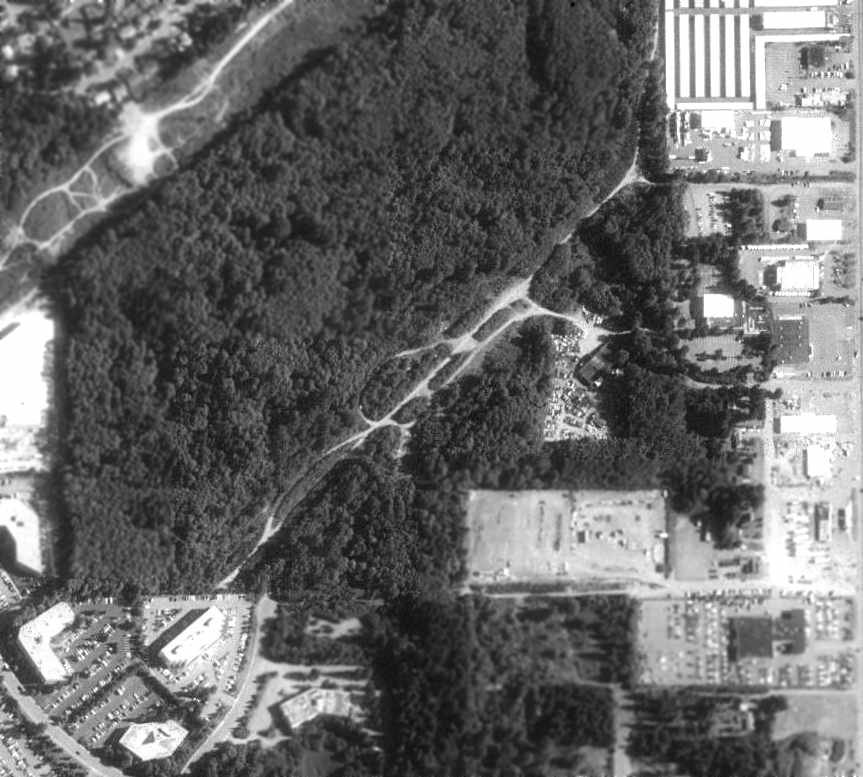
The 1990 USGS aerial photo depicted the remains of the runway,
which were still visible, although the site had become heavily overgrown by trees.
Traces of the southwestern-most portion of the former runway were also still visible,
extending into the office park which had been constructed on the edge of the former airport property.
By the time of the 1994 USGS topo map, the northeastern end of the former airport site
was depicted as the City Center Park.
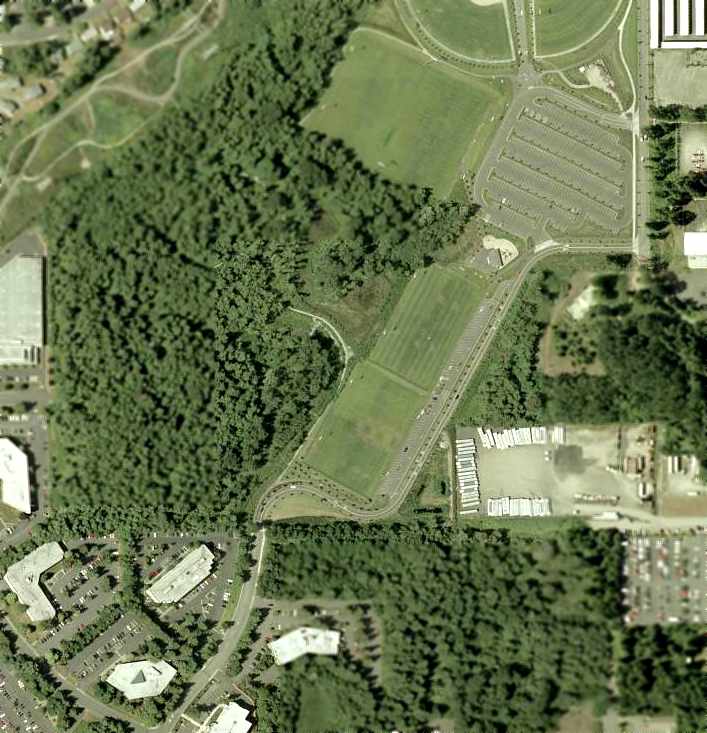
By the time of the 2002 USGS aerial photo,
even the remains of the runway were gone,
with the majority of the site of the former airport having been redeveloped with parking lots & grass fields.
Steve Martin recalled, “ Many years later, after the airport property had been sold & made into the soccer & baseball fields of Celebration Park,
I went searching for those tie-down anchors, but to no avail, as I think they were bulldozed under without a trace remaining.”
The site of Evergreen Airport is located
northwest of the intersection of Pacific Highway South & South 336th Street.
____________________________________________________
Mueller-Harkins Field / Clover Park Technical College Airfield, Clover Park, WA
47.174, -122.5 (Southwest of Seattle, WA)
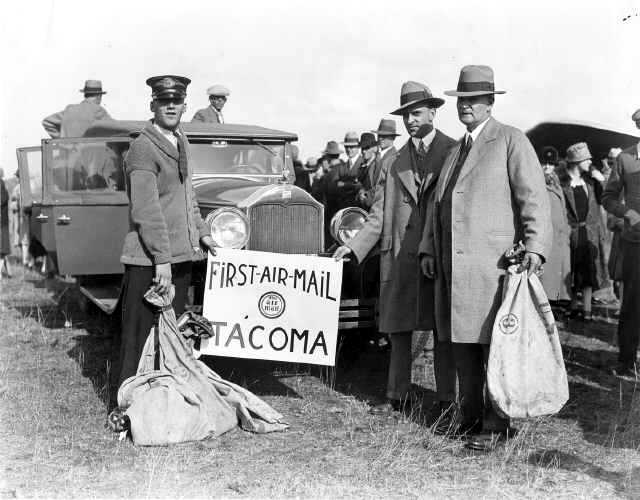
A 9/7/27 photo of the inauguration of direct airmail & passenger service at Tacoma's Mueller-Harkins Airport.
According to a City of Lakewood web site (via Chris Kennedy),
the property of the Tacoma Speedway was sold in October of 1922 (after going bankrupt)
and the Mueller-Harkins Airport was established.
The earliest photo which has been located of Mueller-Harkins Airport was a 9/7/27 photo of the inauguration of direct airmail & passenger service at the airport.
After the first bag of air mail arrived, Postmaster Clyde J. Backus, right, turned it over to department employee Alfred Bottiger, left, who carried it to the city by automobile.
Pictured in the center is R. A. Mueller.
Over 2,500 people waited 2 hours at the airport to cheer the arrival of the first airmail plane of the Pacific Air Transport Co.
According to Scott Kimball, "My Dad flew in the Tacoma area starting in gliders in 1928
and I believe it [Mueller-Harkins] was open then.
I believe he flew A Standard with an OX-5 powerplant out of this field."
Mueller-Harkins was described in the 1929 Standard Oil Airport Directory (according to Chris Kennedy)
as "Field inside of wooden speedway oval."
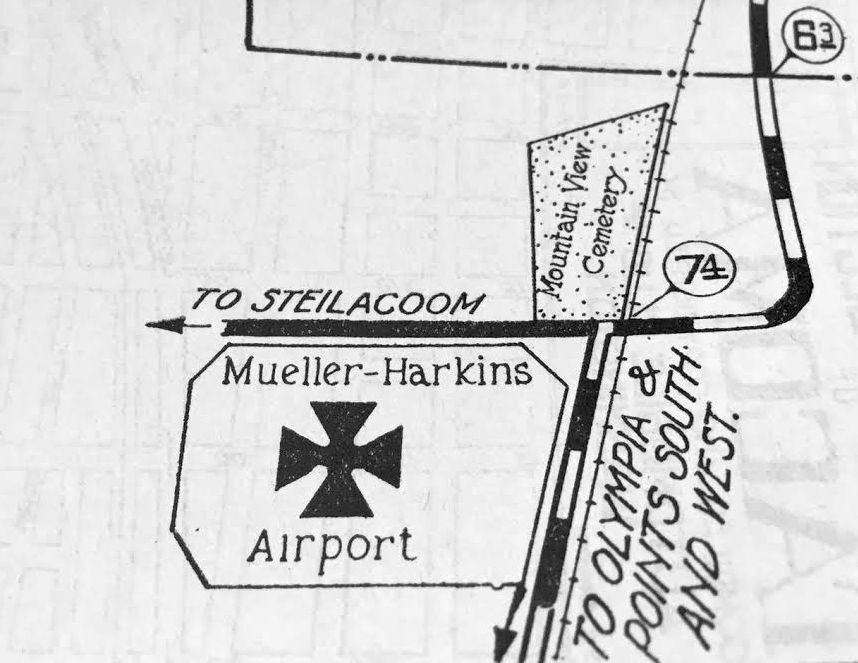
The earliest map depiction which has been located of Mueller-Harkins Airport was on a 1930 map (courtesy of Kevin Walsh),
which depicted it as a roughly rectangular property outline.
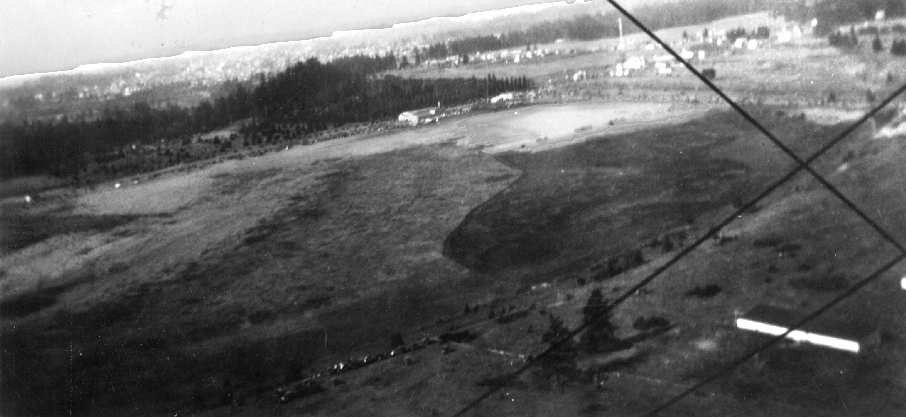
The earliest photo which has been located showing Mueller-Harkins Field was a 1931 aerial taken during the 1931 Air Tour by Wildey "Bud" Kimball (courtesy of Scott Kimball).
The photo was "taken by my Dad the summer he soloed in power", according to Scott Kimball.
It also depicted a "Richfield tower" along the top-right of the image.
These Richfield towers were built along the major flyways for both advertising
and as a guide to pilots especially at night.
They had their name in lighted letters down the tower.
"The one shown in the image was taken down in about 1970."
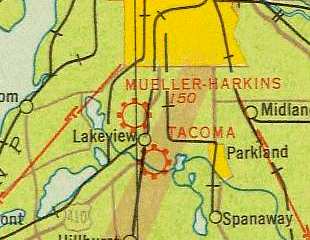
Mueller-Harkins Field, as depicted on the 1933 Seattle Airways Chart.
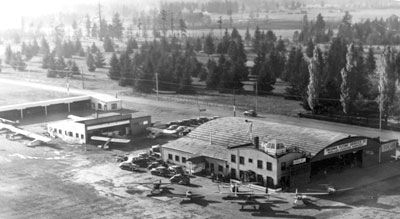
An undated aerial view of hangars & aircraft at Mueller-Harkins Field.
The Airport Directory Company's 1937 Airports Directory (courtesy of Bob Rambo)
described Mueller-Harkins as having two 3,600' sod runways, oriented north/south & east/west.
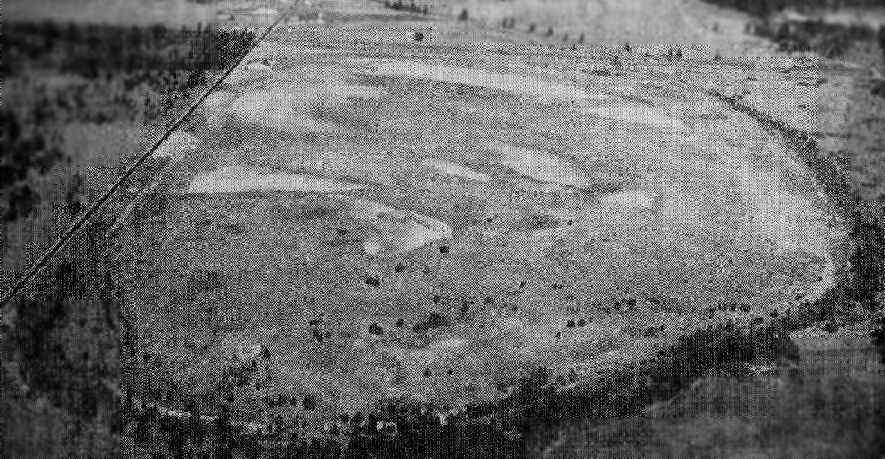
An undated aerial view of Mueller-Harkins Field from The Airport Directory Company's 1938 Airports Directory (courtesy of Chris Kennedy).
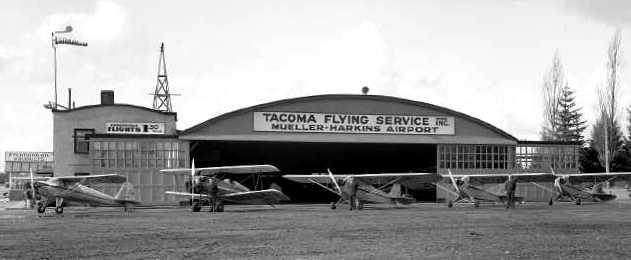
A February 1940 photo of 4 monoplanes & a biplane in front of the Tacoma Flying Service hangar at Mueller-Harkins Airport.
The Tacoma Flying Service, managed by Ben Barry (standing next to the center plane), was one of 3 aeronautical firms with headquarters at Mueller-Harkins Airport.
In 1940 the Tacoma Flying Service had a contract with the Federal Government under the civilian pilot program established by the Civil Aeronautics Authority to train new pilots.
At that time they had 30 students from the College of Puget Sound & Pacific Lutheran College.
The schools' 2 flight instructors, Norvel Norton (next to the biplane) and Bernard "Bud" Oswald (far right), stand next to their planes.
The Mueller-Harkins Airport described as one of the finest privately-owned fields in the northwest, with 3,500' of excellent runway.
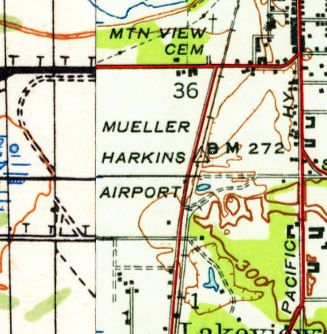
The 1941 USGS topo map depicted Mueller-Harkins Airport as an open area.
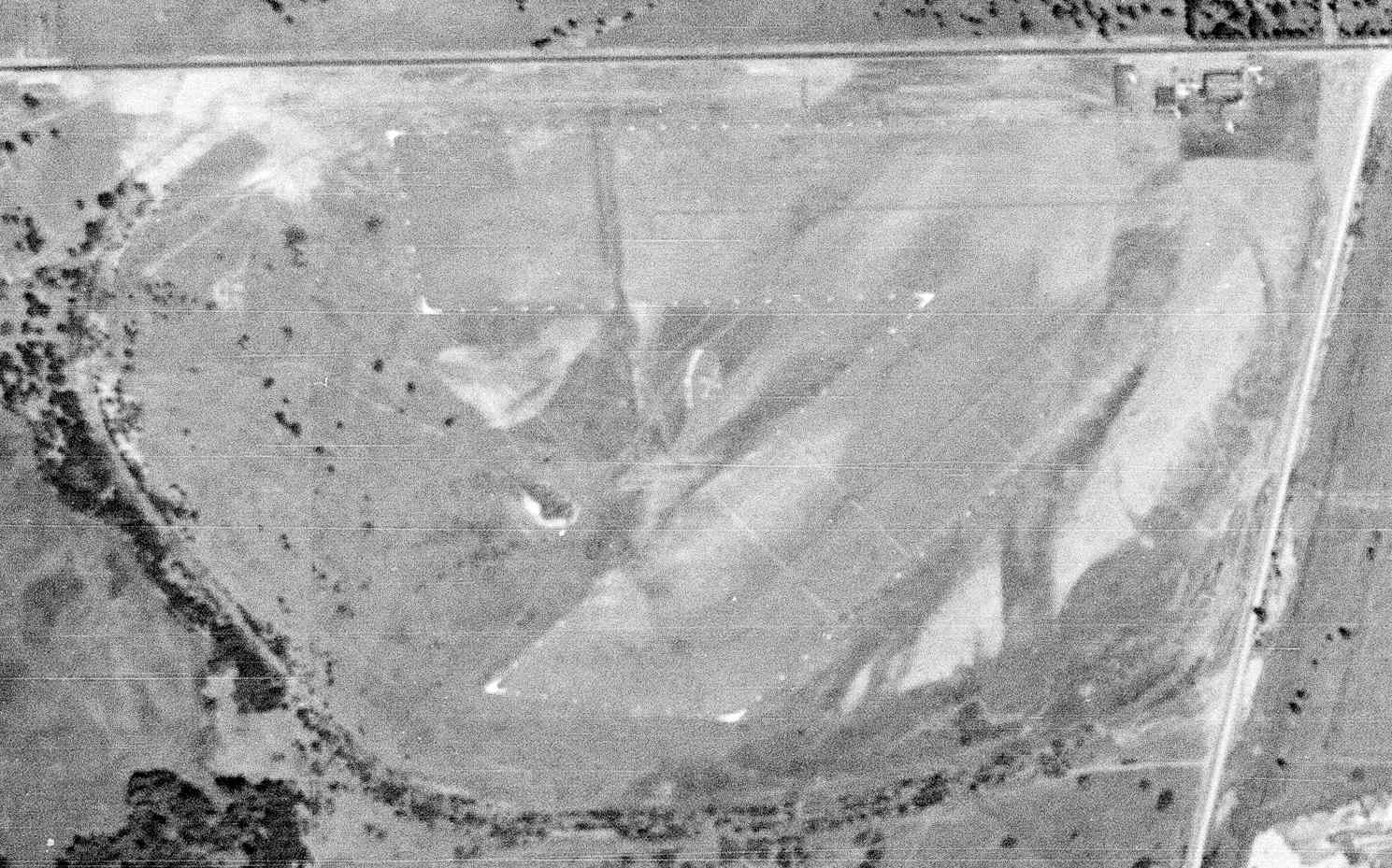
The last photo which has been located of Mueller-Harkins Airport was a 7/10/41 USGS aerial view.
It depicted the field as having a few small buildings at the northeast corner & 2 unpaved runways.
According to a history of the city of Lakewood,
"The City of Tacoma used the airstrip as its commercial field for a time,
and national air shows were held at the site until World War II."
The 1944 USGS topo map still depicted Mueller-Harkins Airport.
On 7/21/44, Mueller-Harkins Airport was condemned & taken to support the war effort.
The property then became a Naval Advance Base (Naval supply depot).
The 1948 USAF Target Complex Chart did not depict any airfield at the site,
but instead a group of buildings, labeled "Naval storehouse".
In 1949, some of the old Navy base was declared surplus & signed over to the Clover Park School District
and by 1954 Clover Park Vocational Technical Institute had received the northern section of the Navy base.
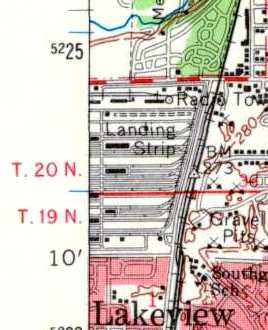
The 1961 USGS topo map depicted a single east/west unpaved runway, labeled simply as “Landing Strip”.
Neither the October 1962 Seattle Sectional Chart (courtesy of Steve Martin), the 1963 WA Pilot's Guide (courtesy of Ron Dupas),
nor the 1967 Seattle Sectional Chart (courtesy of John Voss) depicted an airfield in operation at this location.
By 1971 Clover Park was operating as an airfield again, operated by the Clover Park Technical College.
By this time, the small airport was situated in what have become a very awkward location:
a mere one mile north McChord AFB,
almost directly along the extended centerline of McChord's primary runway.
In Scott Kimball's words, "I learned to fly at this school 1971-1973.
As it was a state-run aviation school,
Clover Park had a special arrangement with the Air Force at McChord.
When I was there we took off on an old road used as a runway
and landed on a grass strip parallel and to the south of the paved portion
(this was done for building clearance & minimum take-off roll).
Some time after I left the grass strip was paved & used exclusively.
We flew an approximately 500' AGL (800' MSL) pattern only to the North side of the field
using specific entry points to the west & northwest.
Clover Park operated it's own 'tower' manned purely by the student pilots
which functioned as an advisory to the few outside pilots coming in.
The school preferred to have pilots get prior permission before coming in,
but I never heard them complain to anyone."
No airfield at this location was depicted on the January 1975 Seattle Sectional Chart (courtesy of Chris Kennedy).

The earliest aeronautical chart depiction which has been located of Clover Park Airfield was on a circa 1980s military aeronautical chart (courtesy of Lee Corbin).
It depicted Clover Park as having a single east/west runway.
However Clover Park Airport was still not depicted on the January 1987 Seattle Terminal Chart (courtesy of Mitchell Hymowitz).
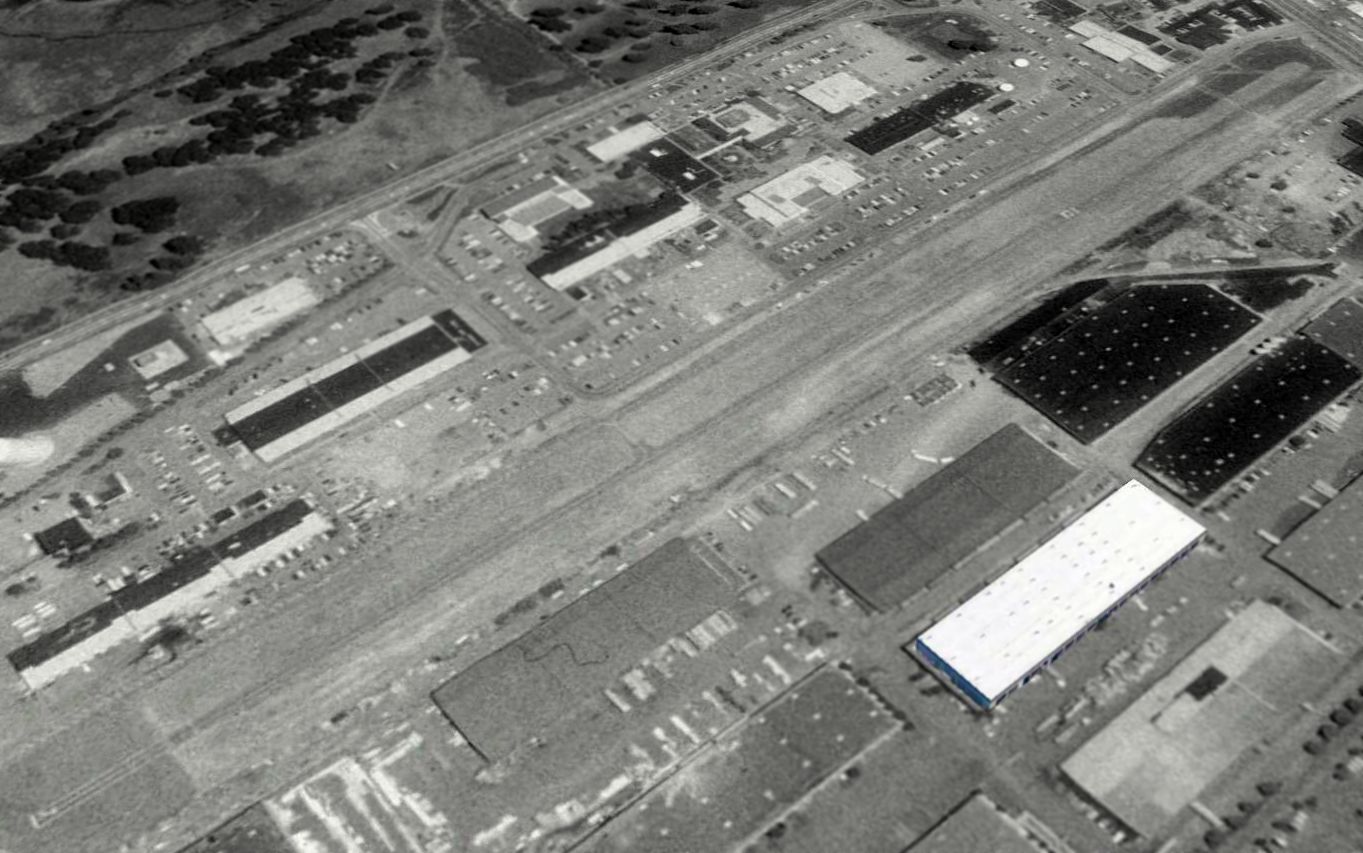
A 1990 USGS aerial view looking northeast depicted the Clover Park Technical College Airfield
as having a single east/west asphalt runway, marked with runway numbers at each end.
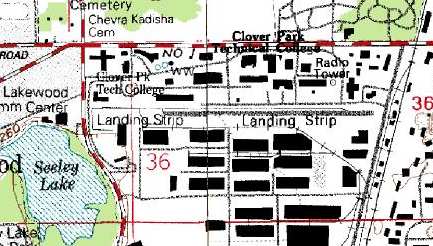
The 1994 USGS topo map depicted Clover Park as a single 2,800' east/west runway, labeled simply as "Landing Strip".
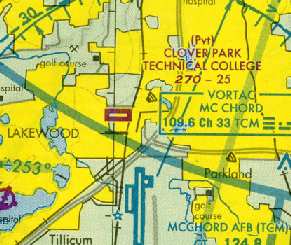
The 1999 Seattle Terminal Area Chart (courtesy of Scott Kimball)
depicted "Clover Park Technical College" as a private airfield, with a single 2,500' paved east/west runway.
Rich Gregory recalled, “The flight school moved in 2001.
I was taking classes there at the time & flew the 1st airplane (to the new Thun Field campus)
on April 3, 2001 & my last flight in or out of S37 was on April 5, 2001.”
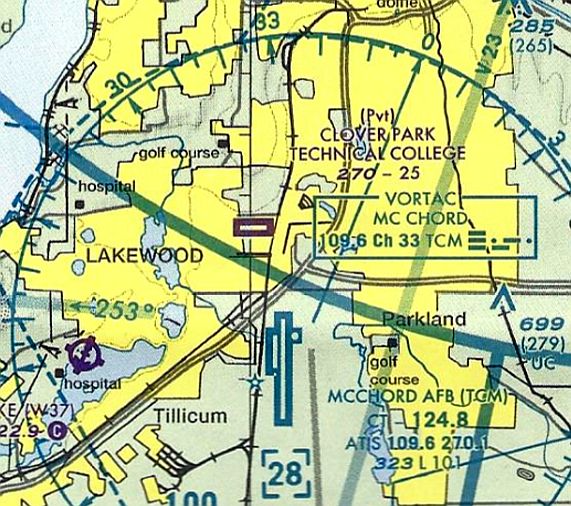
The last aeronautical chart depiction which has been located of the Clover Park Airfield
was on the June 2002 Seattle Terminal Area Chart (courtesy of Ghery Pettit).
Clover Park Airfield was no longer depicted on the December 2002 Seattle Terminal Area Chart (according to Ghery Pettit).
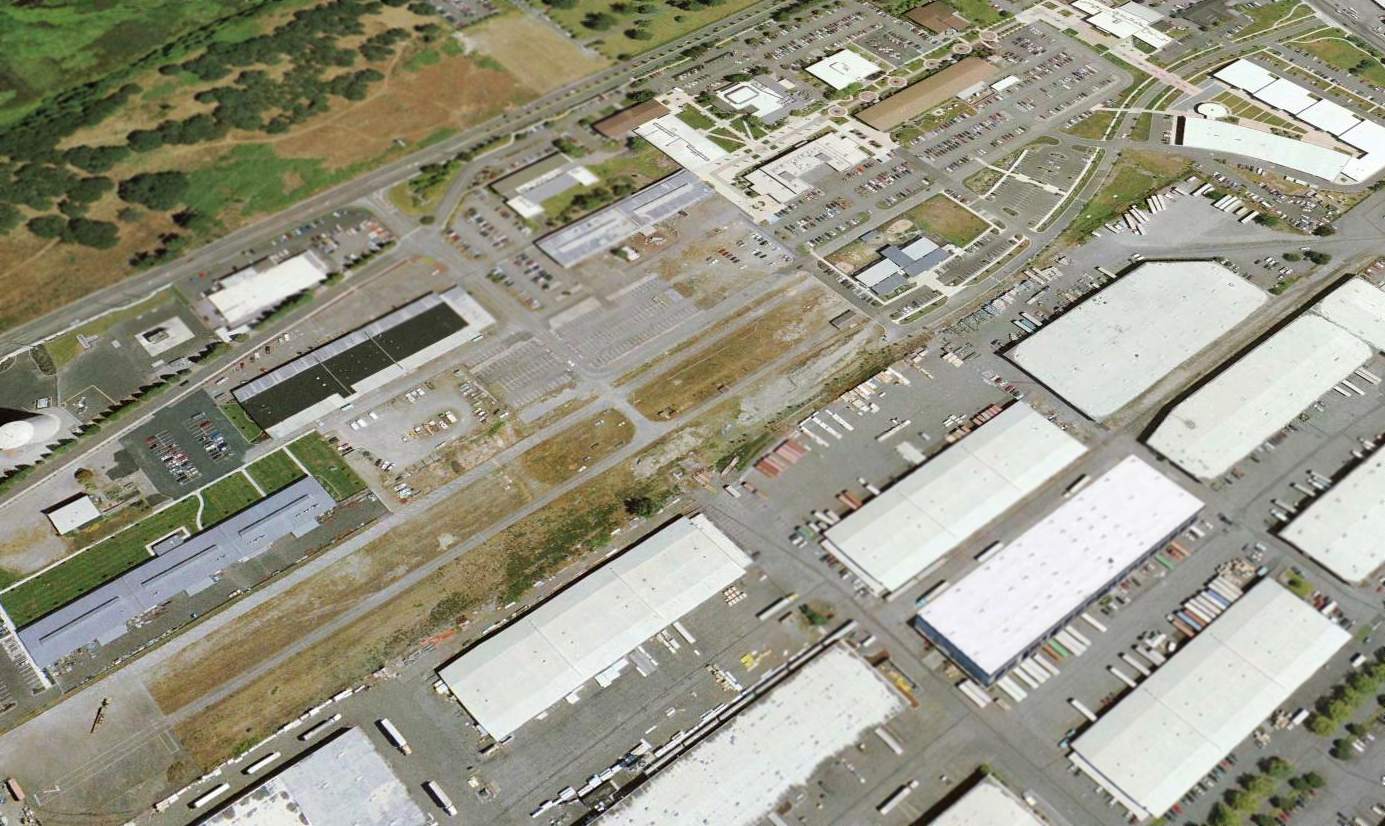
A 2005 aerial view looking northeast at the Clover Park Technical College Airfield
showed that the east end of the runway had been covered with newly-built streets,
but the west end of the runway was still intact, complete with the runway number “7”.
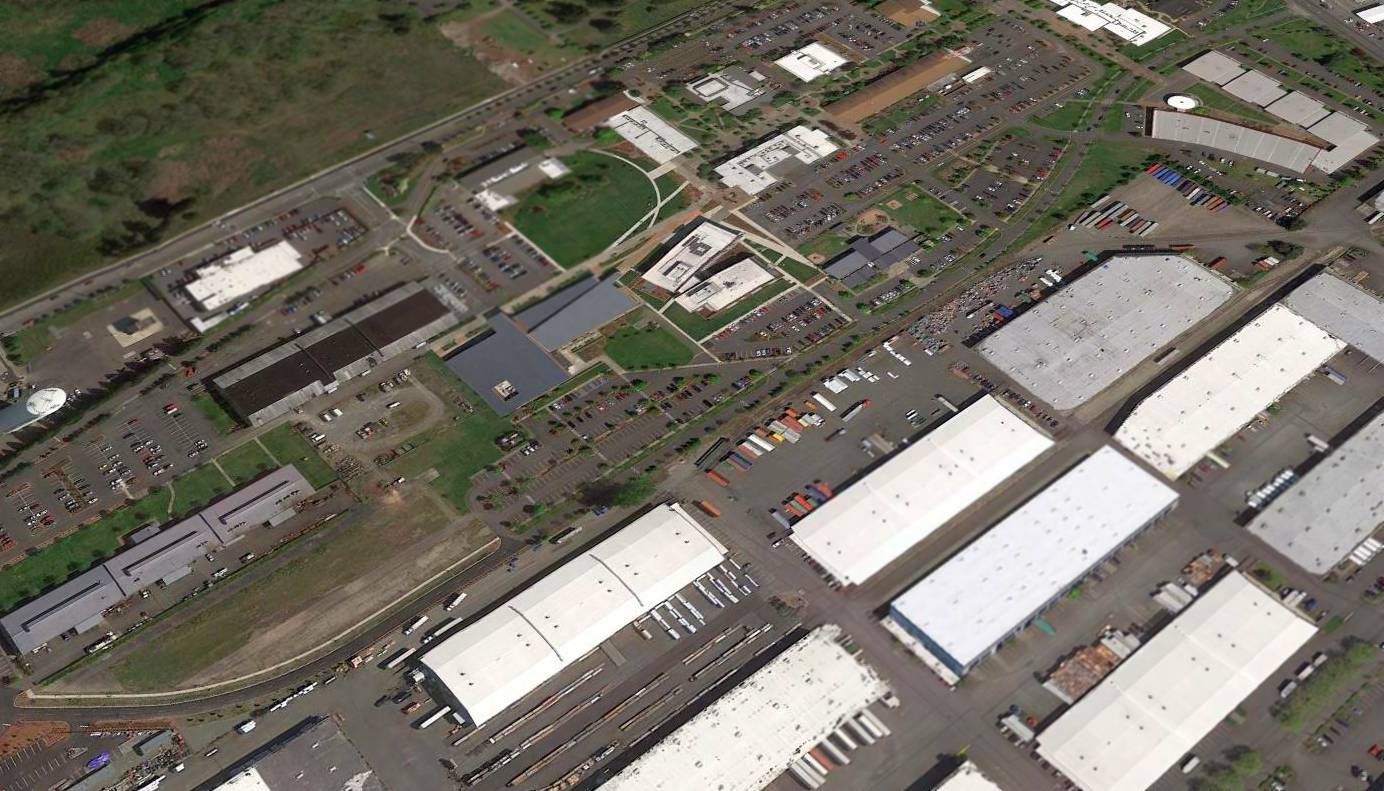
A 2015 aerial view looking northeast at the Clover Park Technical College Airfield
showed that the site had been further redeveloped, to be no longer recognizable as a former airport,
but a small portion of the west end of the runway remained intact (at bottom-left).
The site of the Clover Park Technical College Airfield is located
southwest of the intersection of Lakeview Avenue Southwest & Perimeter Drive.
____________________________________________________
47.24, -122.53 (North-northwest of McChord AFB, WA)
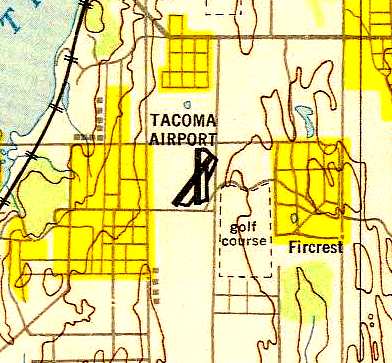
The Tacoma Airport, as depicted on the 1948 USAF Target Complex Chart (courtesy of Chris Kennedy).
This small general aviation airport was evidently established at some point between 1945-48,
as it was not yet depicted at all on the March 1945 Seattle Sectional Chart (according to Chris Kennedy).
The earliest depiction of the Tacoma Airport which has been located
was on the 1948 USAF Target Complex Chart (courtesy of Chris Kennedy).
It depicted Tacoma Airport as having 2 runways, each with a parallel taxiway.
The October 1948 Seattle Sectional Chart (courtesy of Chris Kennedy)
depicted Tacoma Airport as having a 2,200' unpaved runway.
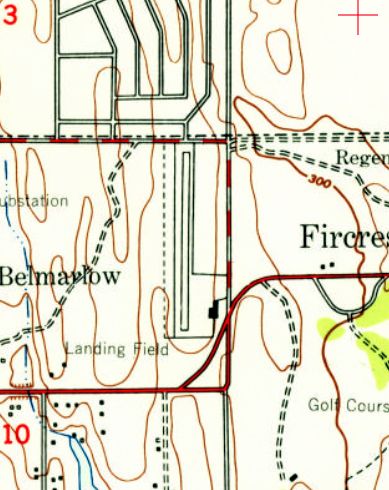
The 1948 USGS topo map depicted Tacoma Airport as a single north/south runway, labeled simply as “Landing Field”.
According to Scott Kimball, "Tacoma Airport was better known throughout the northwest as 'Oswalds',
after 'Bud' Oswald, the owner/operator."
Bill Hamilton recalled, “I started flying in 1954 at Bud Oswald's Tacoma Airport.
One of my instructors was Bud Kimball.
He also handled aircraft sales for Oswalds
and I rode along quite a bit on demo flights around Western Washington with Bud.”
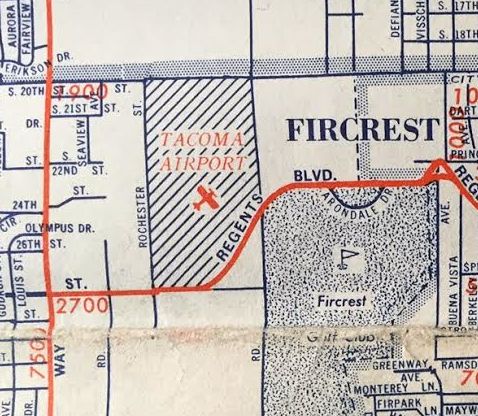
The Tacoma Airport, as depicted on a 1958 street map (courtesy of Kevin Walsh).
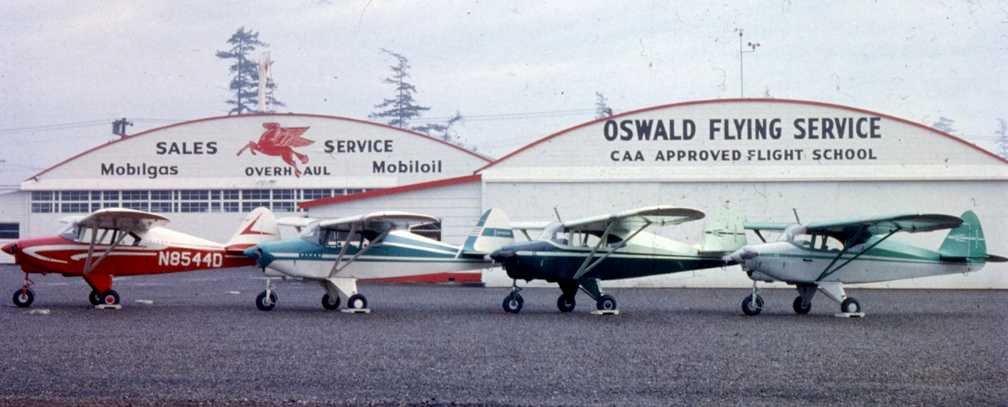
A circa 1959 photo of 4 new Piper Tri-Pacers in front of 2 hangars of Oswald Flying Service at Tacoma Airport
(from the archives of Bud Kimball Photography, courtesy of Jeff Kimball).
The 1959 USGS topo map depicted the Tacoma Airport as having 2 runways,
with several small buildings on the northeast & southeast sides.
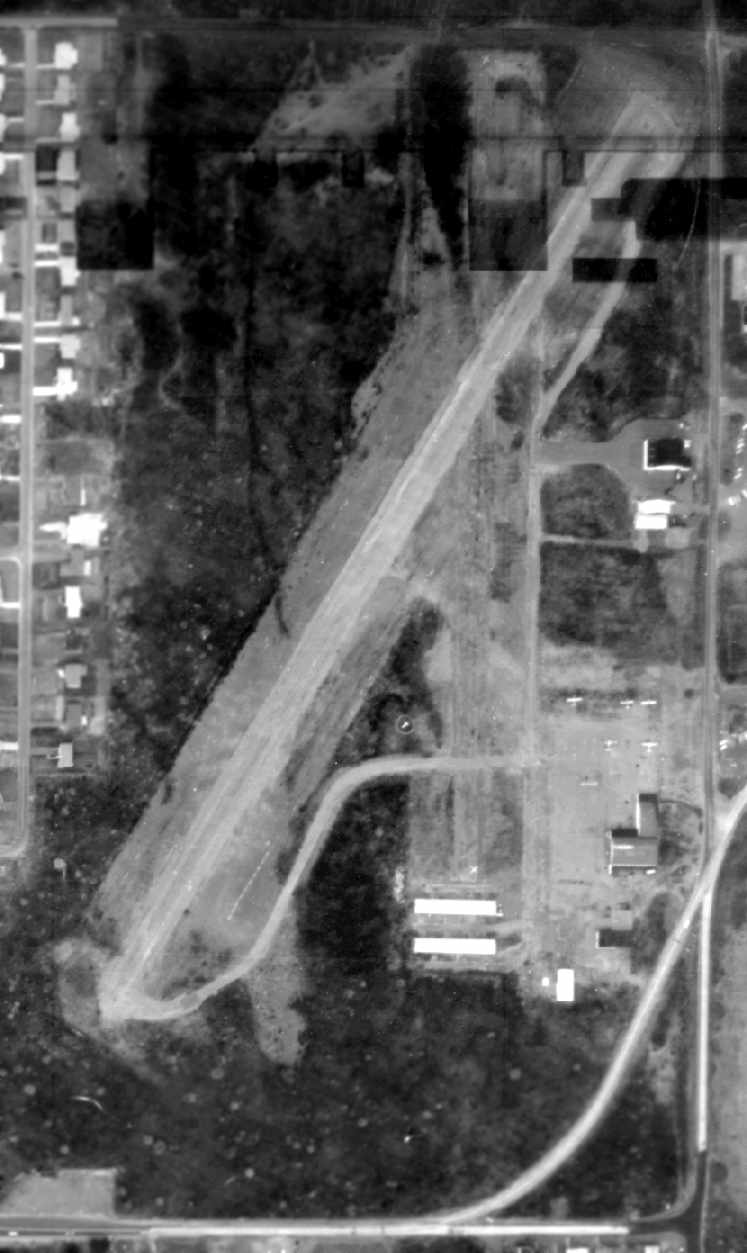
A 1961 aerial photo of Tacoma Airport (from the University of WA Library, courtesy of Greg Peterson).
The field could be seen to have a single northeast/southwest runway,
along with the former north/south runway (on which closed-runway “X” markings were visible).
A total of 5 hangars were visible on the east side of the field,
along with 5 single-engine aircraft.
The 1962 AOPA Airport Directory described Tacoma Airport as having a single 2,400' oiled Runway 1/19,
and listed the operator as Oswald Flying Service.
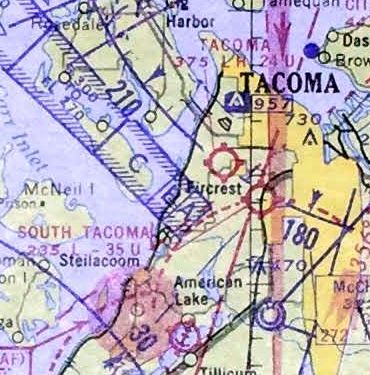
The October 1962 Seattle Sectional Chart (courtesy of Steve Martin)
depicted Tacoma Airport as having a 2,400' unpaved runway.
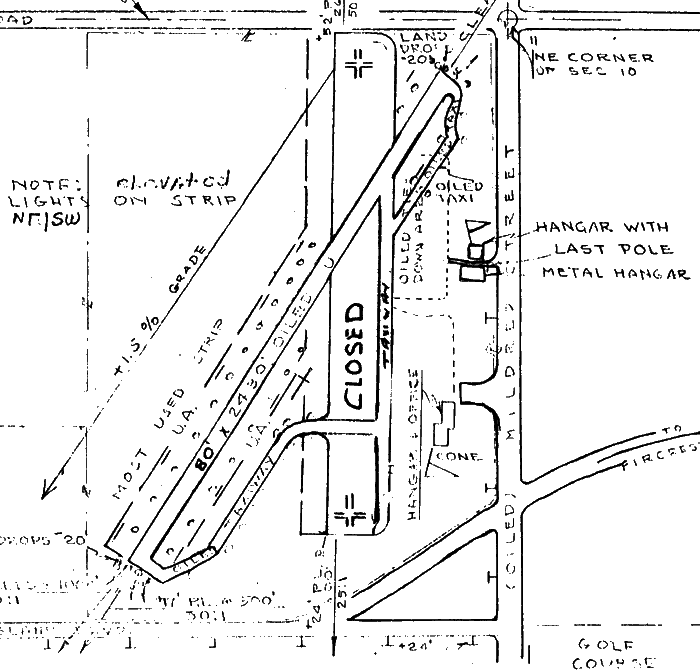
The 1963 WA Airport Directory (courtesy of Ron Dupas)
depicted Tacoma Airport as having a single 2,430' asphalt northeast/southwest runway.
The former north/south runway was still depicted in the airfield diagram, but was labeled "closed".
An office & several hangars were depicted on the east side of the field.
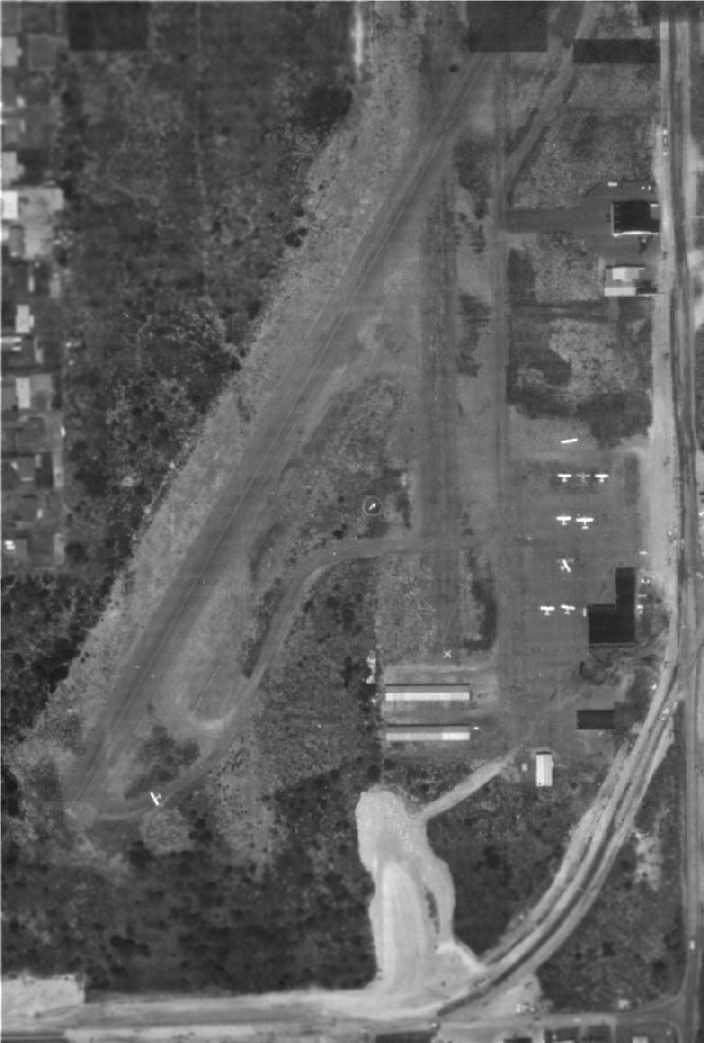
In a 1965 aerial photo of Tacoma Airport (from the University of WA Library, courtesy of Greg Peterson),
the field's configuration was basically unchanged compared to the 1961 aerial photo,
with a single northeast/southwest runway, the closed north/south runway, and 5 hangars.
A total of 9 single-engine aircraft were visible on the east side of the field,
including one taxiing to the runway for takeoff.
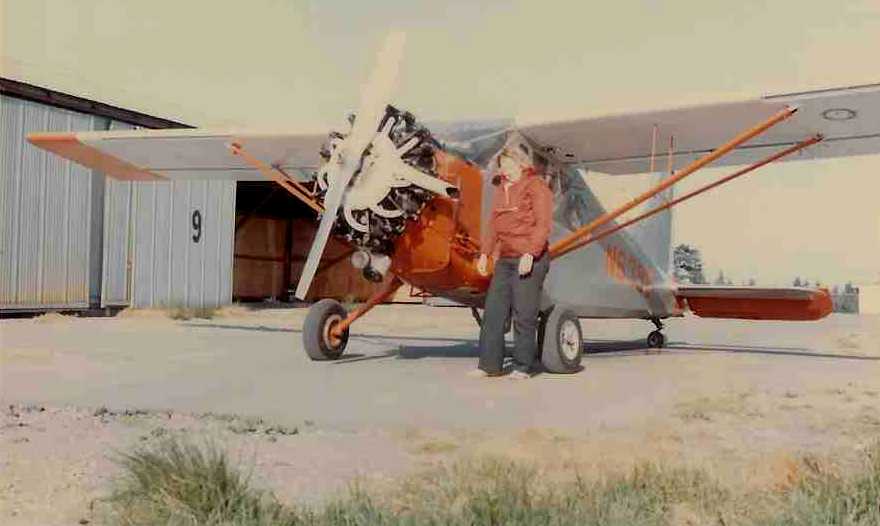
A circa 1965 photo (courtesy of Jeff Kimball) of Majorie Kimball in front of “my Dad's highly modified Stinson L-5
taken in between the rows of T-hangars in the southwest corner of Oswald's [Tacoma Airport], near the south end of the closed runway.
The L-5 was quite a critter... Dad's had a 225hp Lycoming R-680 from a PT-17 Stearman, wingtips extended 30 inches each & squared,
plus oversized wheels & tires along with the mods for the photo missions.
Slow... so cross-country was an adventure. But it still had the drooping ailerons & something like 45 degrees of flaps so you had a full wing flap if you wanted it.
You could probably land it in a tennis court.”
The rumor was the fire was an insurance job on the airplane in the slot next to dads, but no one ever proved it.. Dad's L5 would be a real oddity if it was still around...”
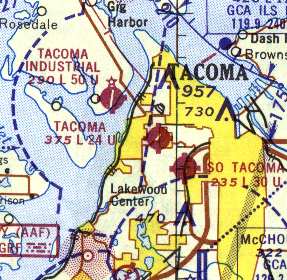
The 1967 Seattle Sectional Chart (courtesy of John Voss)
described Tacoma Airport as having a single 2,430' asphalt northeast/southwest runway.
The Aerodromes table on the chart included the remark, "N/S runway permanently closed."
According to Jeff Kimball, “There was a fire in 1969 that burned the south row of hangars including our L-5, and 6 or 7 other airplanes at Tacoma Airport.”
According to Scott Kimball, Tacoma Airport "closed about 1973."
A 1974 USDA aerial photo of the site of Tacoma Airport (from the University of WA Library, courtesy of Greg Peterson)
showed that the property was in the process of being redeveloped,
with all of the airport buildings except one having been removed,
and the outline of the runways still somewhat recognizable.
Tacoma Airport was not depicted at all on the 1974 USGS topo map
or on the January 1975 Seattle Sectional Chart (courtesy of Chris Kennedy).
In a 1983 aerial photo (from the University of WA Library, courtesy of Greg Peterson)
not a trace of Tacoma Airport was still perceptible as the property had been densely redeveloped.
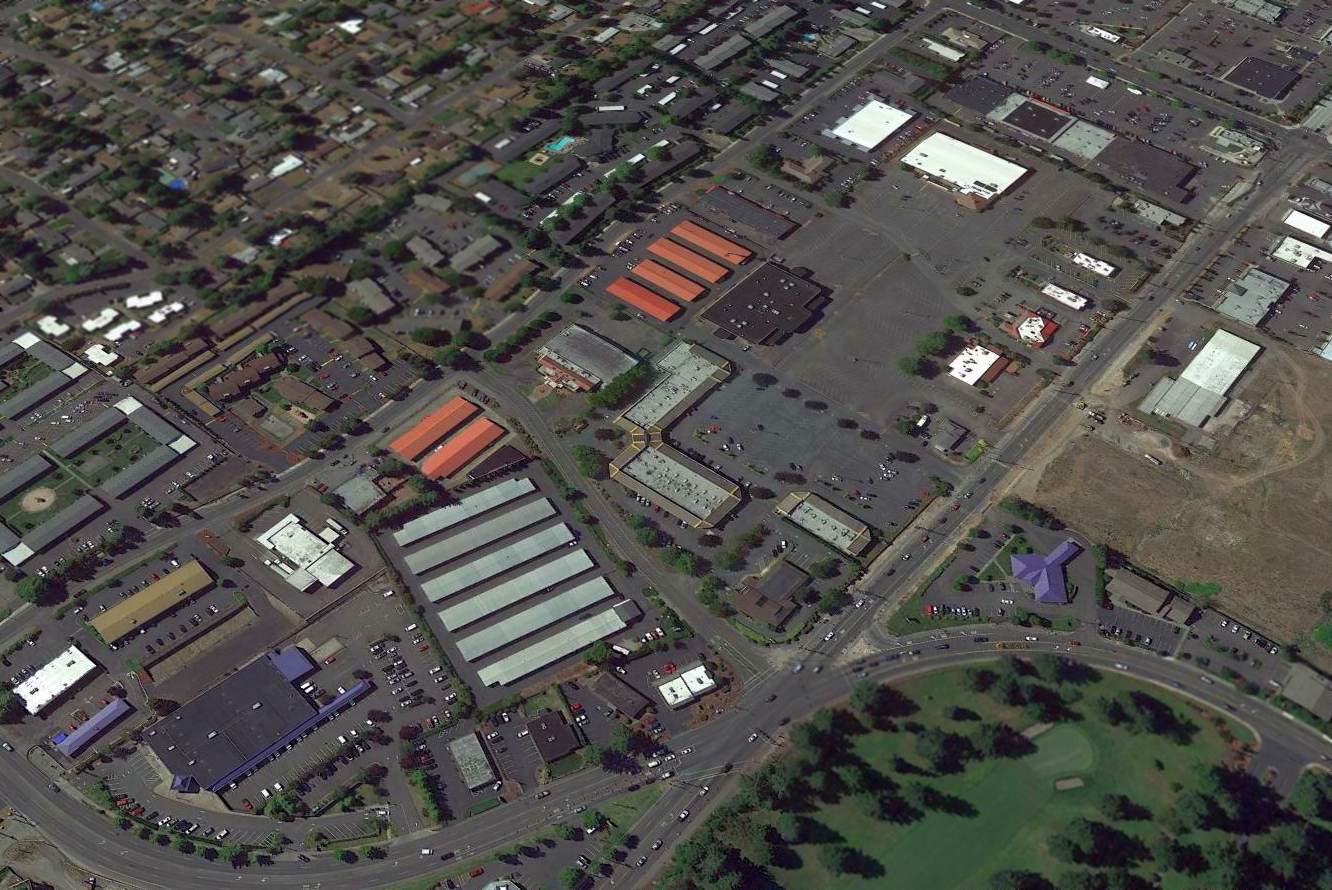
A 2016 aerial view looking northwest showed not a trace remains of Tacoma Airport.
The site of Tacoma Airport is bounded by 19th Street on the north, 27th Street on the south,
Mildred Street on the east, and Cascade Place West on the west.
Another small general aviation field, the former South Tacoma Airpark
was located less than 2 miles to the southeast of Tacoma Airport.
____________________________________________________
South Tacoma Airpark / Tacoma Aero Club Airfield, Tacoma, WA
47.21, -122.49 (North-northwest of McChord AFB, WA)
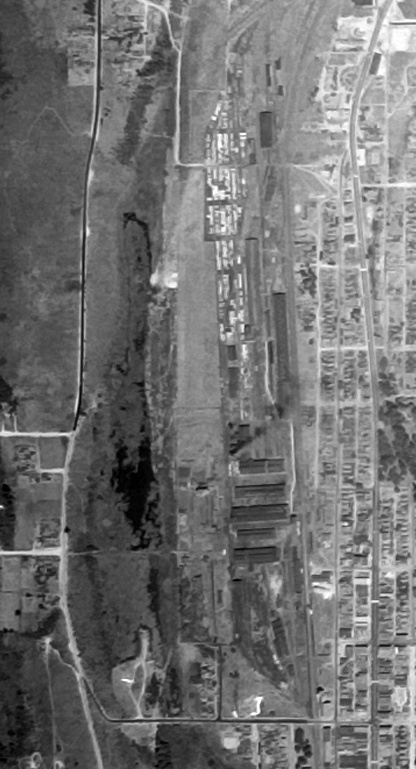
The clearing of the South Tacoma Airport was visible on a 7/10/41 USGS aerial photo.
According to a 1995 WA State Department of Health report,
"The South Tacoma Airport operated from 1936-73."
According to Scott KimballI, "In its early days (prior to WW2?),
South Tacoma had a 'slew' parallel to the hard runway that was used as a float base."
Bill Hamilton recalled, “The 'slew' that was used for floatplane landings...
It was rather narrow & not very long but it worked.”
The clearing of the South Tacoma Airport was visible on a 7/10/41 USGS aerial photo.
South Tacoma Airport was not depicted at all on the March 1945 Seattle Sectional Chart (according to Chris Kennedy).
It may have been temporarily closed during WW2,
like many other small civilian airports along the coasts,
due to wartime security concerns.
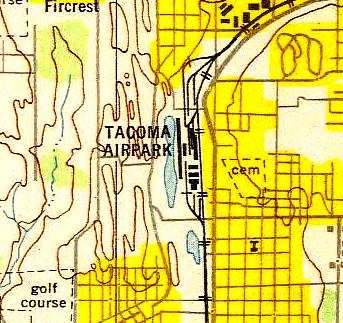
The airfield was evidently reopened at some point between 1945-48,
as the 1948 USAF Target Complex Chart (courtesy of Chris Kennedy)
depicted “Tacoma Airpark” as having a single north/south runway.
The October 1948 Seattle Sectional Chart (courtesy of Chris Kennedy)
depicted “Tacoma Airpark” as having a 3,500' unpaved runway,
along with a 2,000' seaplane water landing area.
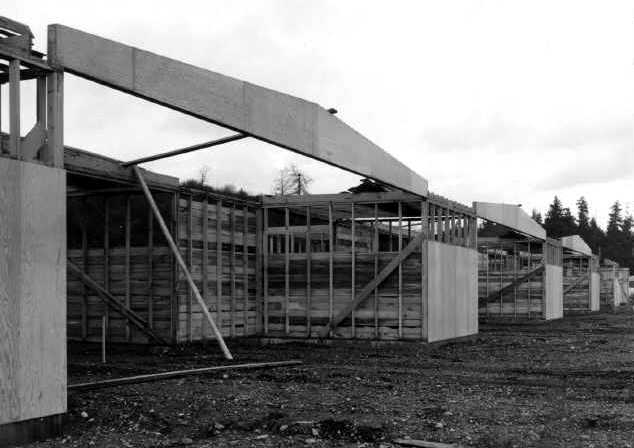
The earliest photo which has been located of the South Tacoma Airport
was a 1/10/58 view of a new hangar being built from plywood.
The narrow, slightly bent pieces of plywood above the plywood forms were box beams.
They were probably put together at Weber Lumber Co. a few days before.
These are believed to be some of the 10 new T-hangars built by C.E. Munson, contractor, which held 5 planes to a side.
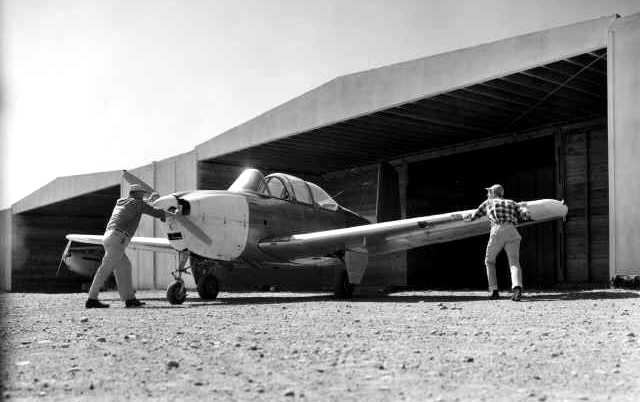
A 9/9/58 photo of a Beechcraft T-34 (owned by the McChord Flying Club) being wheeled into a T-hangar at the South Tacoma Airport.
Frank Bly is pushing with his hands on the propeller.
Mr. Bly would built a hangar at the South Tacoma Airport in the late 1950s,
which he used to restore & keep his 1931 Stinson W.
South Tacoma Airport was still not depicted on the 1958 USGS topo map.
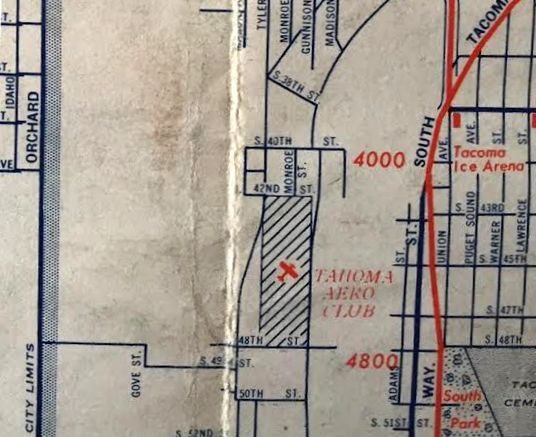
South Tacoma Airport was labeled “Tacoma Aero Club” on a 1958 street map (courtesy of Kevin Walsh),
the only time this name has been seen used for the airport.
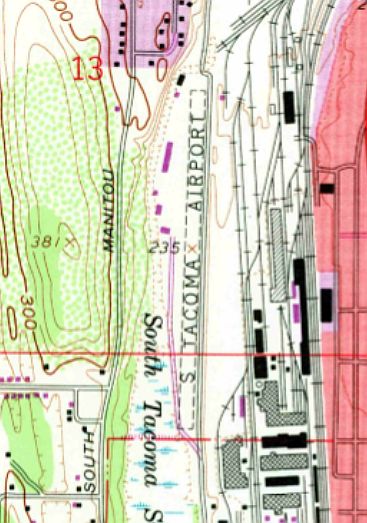
The 1961 USGS topo map depicted the South Tacoma Airport as having a single unpaved north/south runway,
with a small building on the northwest side.
The 1962 AOPA Airport Directory described the field as having a 3,400' gravel & turf Runway 18/36,
and listed the operator as Gross Aviation.
According to Scott Kimball, "Gross Aviation was owned by Chuck Gross."

The October 1962 Seattle Sectional Chart (courtesy of Steve Martin)
depicted South Tacoma Airport as having a 3,500' unpaved runway.
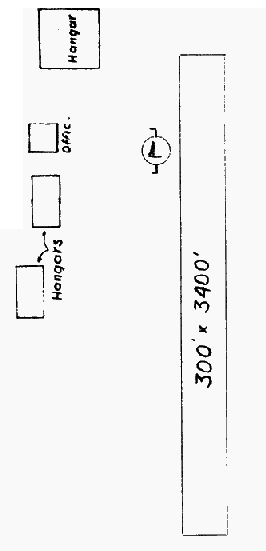
The 1963 WA Airport Directory (courtesy of Ron Dupas)
described South Tacoma Airport as having a single 3,400' gravel north/south runway.
Three hangars & an office building were depicted on the northwest side of the field.
The Aerodromes table on the 1964 Seattle Sectional Chart (according to Chris Kennedy)
listed the runway configuration as a single 3,500' gravel strip.
Patrick Lehne recalled, “In 1965 my older brother took me for my first ride while he got a lesson from South Tacoma Air Park.
The next day I showed up for my first lesson. The instructor said 'TODAY?'
(It was spitting snow but enough ceiling to do a short hope out over the Sound.)
Because of the hill off Runway 16 it was better to do a 'dog leg' final. So you're low & slow & turning.
When the teacher told me this I just thought 'Ya? So what?' Ignorance was bliss.
The power lines off Runway 34 made approach from there even a bit more dicey.
I would guess the runway to be about 50' wide. And it was hard gravel.
At this time there was 3 hangars & an office in the northwest corner. The buildings in the picture at Runway 34 were not there.
It was all open & flat except for the power lines. I have no memory of water for float planes.”
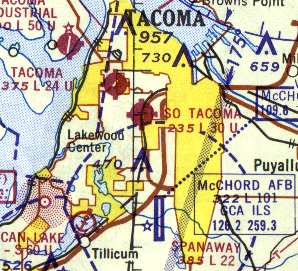
Apparently the runway was paved within the next three years,
as the 1967 Seattle Sectional Chart (courtesy of John Voss)
described South Tacoma as having a single 3,000' asphalt runway.
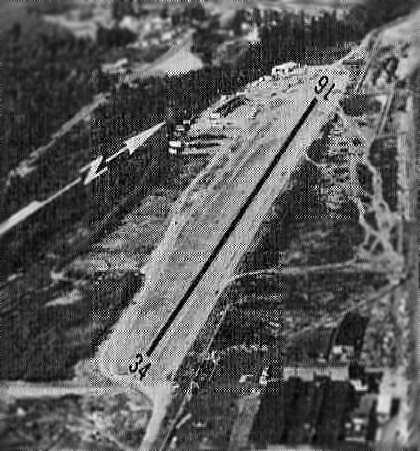
An aerial view looking northwest at South Tacoma Airpark,
from the 1971 WA Airport directory (courtesy of Chris Kennedy).
The 1995 WA State Department of Health report said that South Tacoma Airport closed in 1973,
although this appears to be contradicted by a later aeronautical chart depiction.
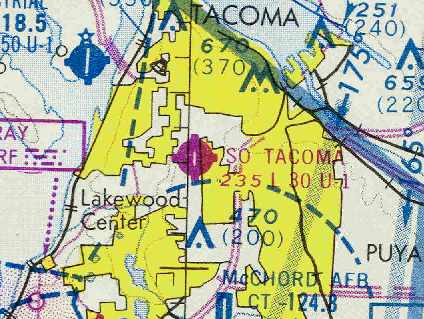
South Tacoma Airport was evidently still open in 1975,
as it was still depicted as an active airfield on the January 1975 Seattle Sectional Chart (courtesy of Chris Kennedy).
It was described as having a single 3,000' paved runway.
The 1976 USGS topo map depicted the South Tacoma Airport as having a single unpaved north/south runway,
with a small building on the northwest side.
South Tacoma Airport was evidently closed at some point between 1975-77,
as it was no longer depicted on the January 1977 Seattle Terminal Area Chart (according to Chris Kennedy)
nor on the 1981 USGS topo map.
In a 1990 aerial photo of the site,
remains of the former runway pavement were still barely visible.
Some kind of industrial building had been built at some point along the south side of the former airport property.
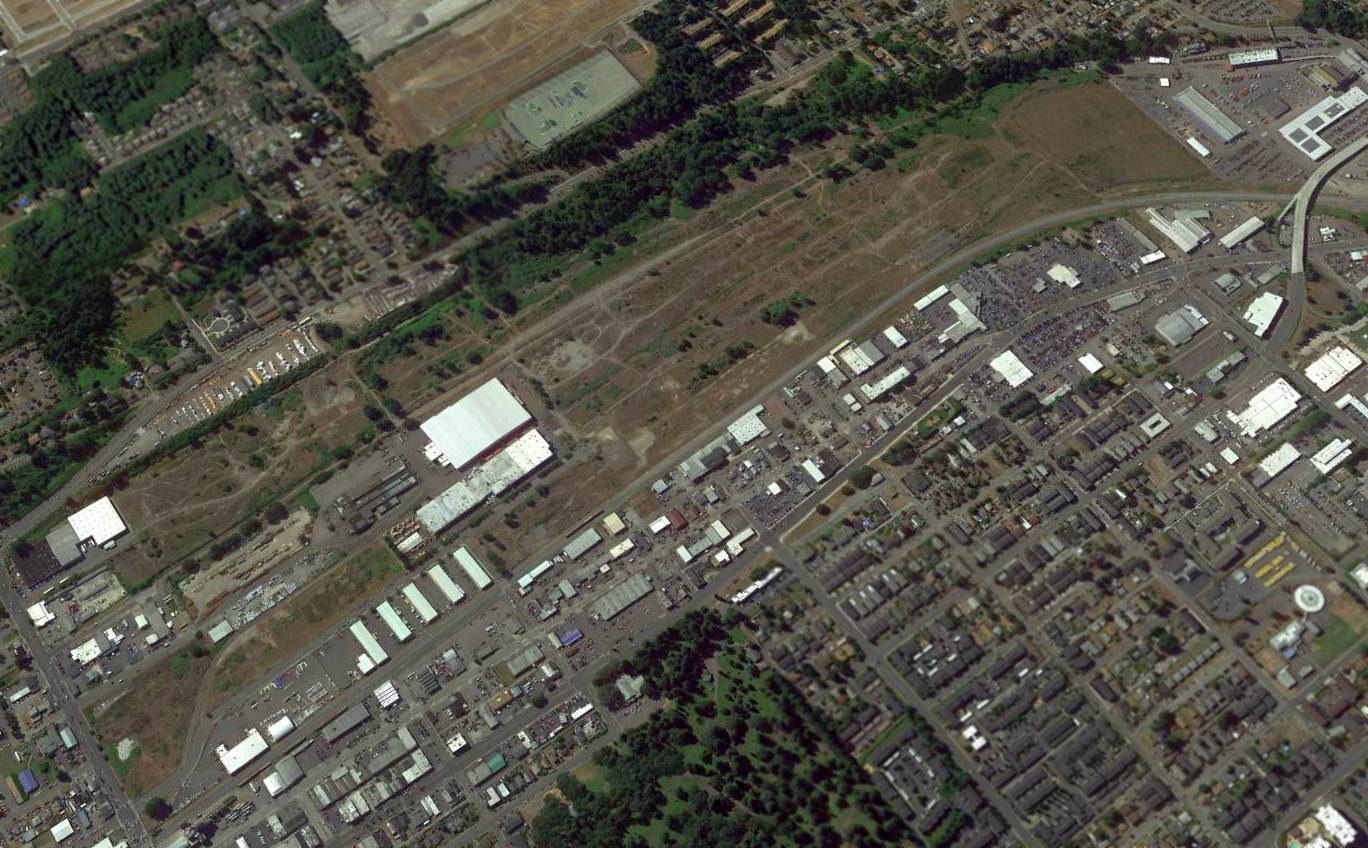
A 2016 aerial view looking northwest showed no trace remaining of South Tacoma Airpark.
The site of the former South Tacoma Airpark is located
north of the intersection of South 56th Street & South Proctor Street.
Another small general aviation field, the former Tacoma Airport
was located less than 2 miles to the northwest of South Tacoma Airpark.
____________________________________________________
Since this site was first put on the web in 1999, its popularity has grown tremendously.
That has caused it to often exceed bandwidth limitations
set by the company which I pay to host it on the web.
If the total quantity of material on this site is to continue to grow,
it will require ever-increasing funding to pay its expenses.
Therefore, I request financial contributions from site visitors,
to help defray the increasing costs of the site
and ensure that it continues to be available & to grow.
What would you pay for a good aviation magazine, or a good aviation book?
Please consider a donation of an equivalent amount, at the least.
This site is not supported by commercial advertising –
it is purely supported by donations.
If you enjoy the site, and would like to make a financial contribution,
you
may use a credit card via
![]() ,
using one of 2 methods:
,
using one of 2 methods:
To make a one-time donation of an amount of your choice:
Or you can sign up for a $10 monthly subscription to help support the site on an ongoing basis:
Or if you prefer to contact me directly concerning a contribution (for a mailing address to send a check),
please contact me at: paulandterryfreeman@gmail.com
If you enjoy this web site, please support it with a financial contribution.
please contact me at: paulandterryfreeman@gmail.com
If you enjoy this web site, please support it with a financial contribution.
____________________________________________________
This site covers airfields in all 50 states.